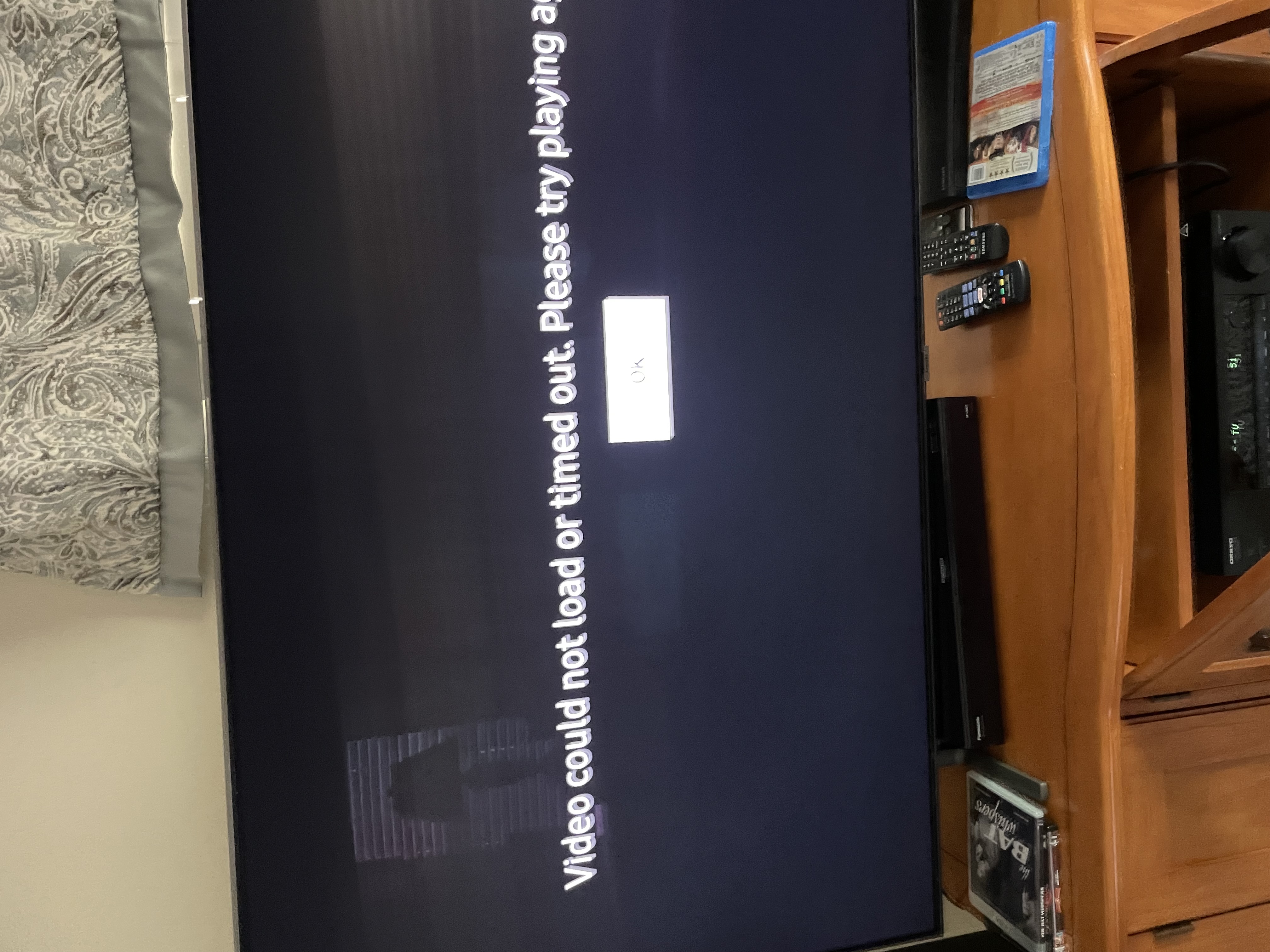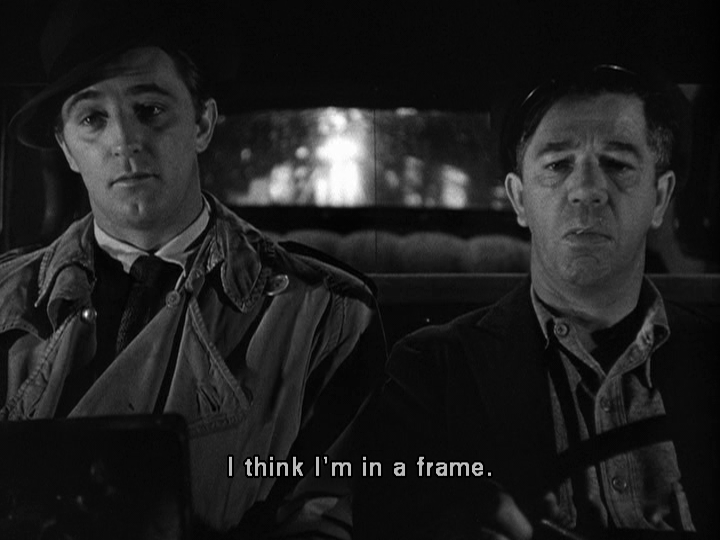
The CRAZY Ways 1920s Movies Were Advertised
https://www.youtube.com/watch?v=vc8SyqtE4W4
creative writing as discovery James ELLROY ON HIS TRILOGY
DRAW A Square with three lines
"Found Film Noir Footage in Bryan Ferry's Music Video 'I fooled around and fell in love': Outsourcing the Past as Allegory of American History Covered Up"

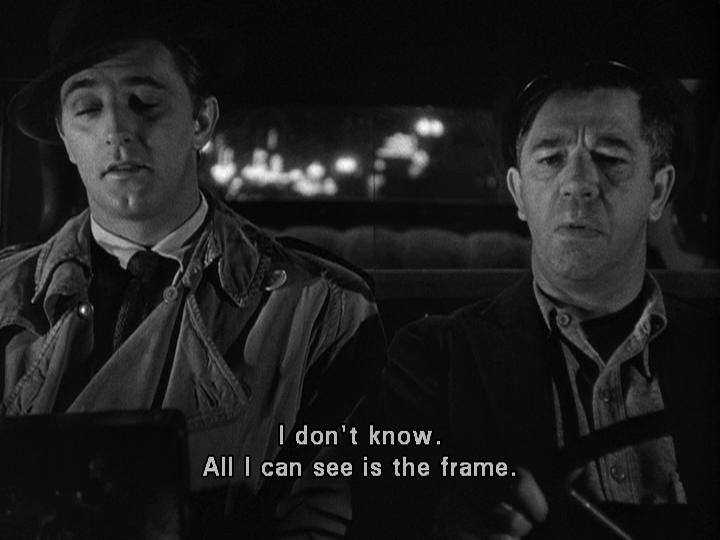

B&W color grading 4K versus blu-ray (Personal note: I cannot for life figure out why anyone would prefer the color grading of the 4K to the blu-ray's.)
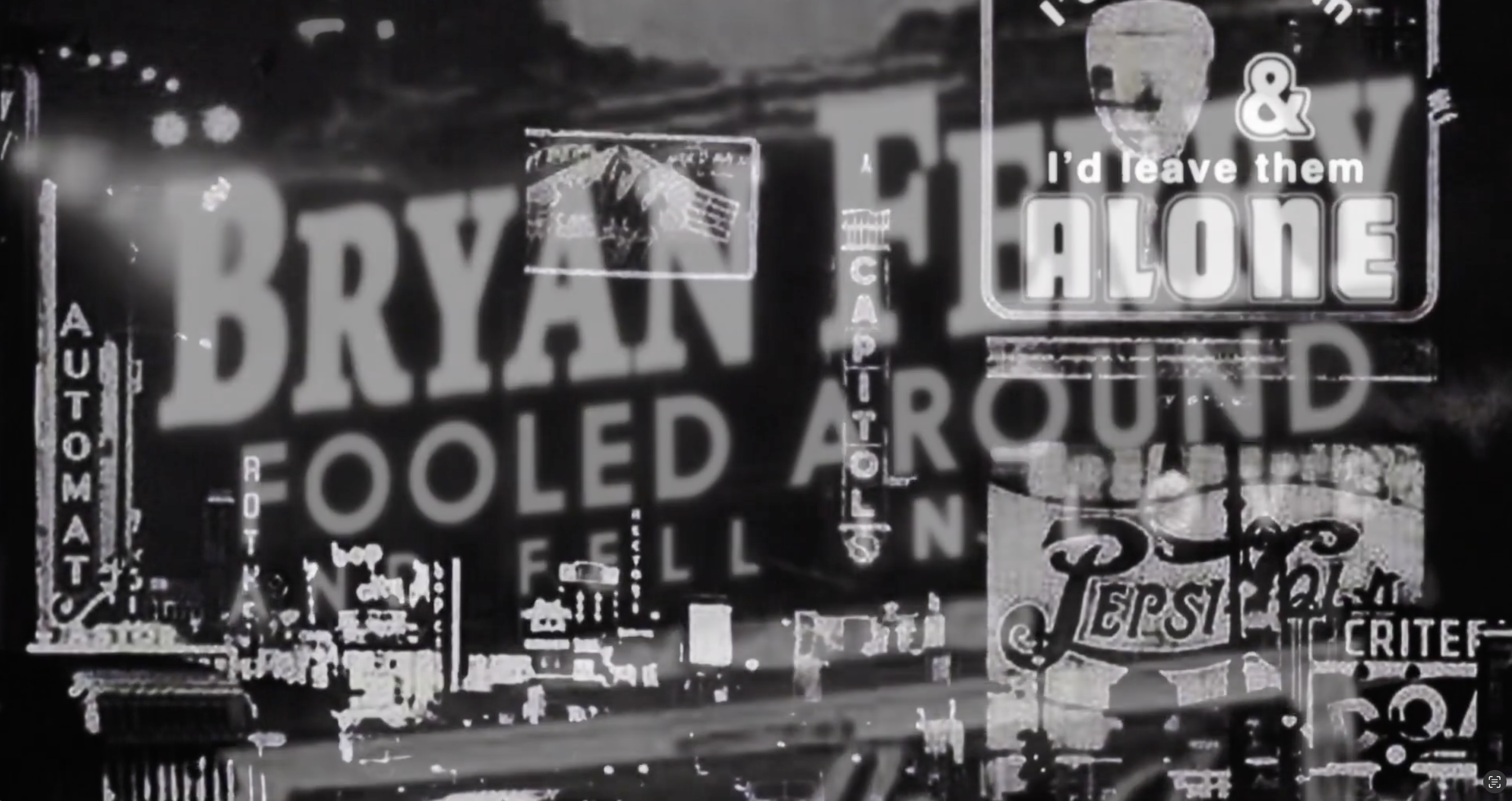
The Classic Hollywood Montage as Illegible Palimpsest
The Ferry music video is not only a cover of an older song. It is an entry ticket into Hollywood film history now available as a streamed film archive, graphic design, photography, urban, neon signage, music, and movie marquee typography. The Culture Industry deindustrialized, its ruins made into the sources of rumination. (One should also keep in mind the relation between this track and the other three tracks Bryan Ferry released together as the Love Letters digital EP in 2022. It is avaialble one at Bryan Ferry.com.)
"‘Fooled Around And Fell In Love’ written by Elvin Bishop in the mid 1970s, a US #3 hit which has been used in countless film soundtracks. Ferry’s inspiration came from the original, which he heard when he was living in America. This track was mixed by Tom Elmhirst in New York.
Summing up the ‘Love Letters’ project, Bryan Ferry comments, “I like extending my repertoire by covering songs from different genres and different times. It can be an interesting challenge, finding the best way to interpret them in my own style – whatever that may be."
https://bryanferry.com/new-bryan-ferry-track-love-letters/
Bryan Ferry - Love Letters (Lyric Video)
My friend and colleague Robert Ray pointed me to "2HB" ["To Humphrey Bogart," with a nod to the film Casablanca], a track on Roxy Music's first album, Roxy Music (1976). Ferry recorded the songagain in 2011 on Let's Stick Together. Ray prefers the second recording.)
From BrianFerry.com 2HB And don't miss Bryan Ferry - Slave To Love (Official Music Video)
For a contrasting edit of a music video, see Empire of Sun's lyrics for "We are the people."
Artist murder in
PHANTOM LADY TRAILER / LES MAINS QUI TUENT BA - ELLA RAINES / FRANCHOT TONE
https://www.youtube.com/watch?v=KczfjwJrGJc
Artist murder in The Dark Corner (1946)
https://www.youtube.com/watch?v=J1lG0hVKvMo
and the dance hall girl in Lured
Lucille Ball, George Sanders - Lured Trailer 2018
Fan edit trailer
https://www.youtube.com/watch?v=lZ7QfWi-oI8
Cohen trailer
https://www.youtube.com/watch?v=1IlbW2LCue0
Empire Of The Sun - We Are The People (Official Music Video)
https://www.youtube.com/watch?v=hN5X4kGhAtU
Empire of the sun - we are the people (sped up) (tiktok version)
https://www.youtube.com/watch?v=joEci9CiBuA
Empire of the sun: “We are the people” [slowed]
See Michel Chion's Words on Screen for a discussion of legibility in narrative film.
How can we read a music video when the images and words are not closely matched, when the image gives the lyrics a new meaning and provide a palimpsest, superimpositions of three or more images, and a surplus of text in addition to the lyrics, much of which is next to impossible to read because the camera moves past it so quickly, and superimposes text and brief clips from four films located in one of the four quandrants of the screen often simulatenously fade in and fade out through dissolves, or creating a new clip by combining two shots from the same film?
One way to proceed would be to read out the source films and clips from them, to reverse the creative practice of finding source films and photographs and selecting shots from them. By taking shots out of chronological sequence and showing them simulateneoulsy instead of sequentially, Bryan Ferry's music video redefines the idea of a Hollywood montage (time passing through ellipses between shots held together by continuous music).
Making the video legible, however, does mean doing a certain violence to it, turning it into stills and cropping shots to reveal what is otherwise hiding. This violence would also make sense of the achronicity of a music cover, the violence done to film and film history by covering the cover (or discovering or uncovering it) through video.
There is an allegory, a reading of the song through an allegory of film noir romance. Using famous 1940s film clips in a movie video for a cover of a song that was released by the original artist around five decades earlier forces the question: What did the original song really mean?
This allegory would also have to render film as American history, history being read as theater marquees for films released in 1934, 1938, and 1940, the geopolitcs of film exhibition (the cover lyrics and of the recognition of the genre of film noir and the titles of the four films for the sources of superimposed clips from films set in Los Angeles, San Francisco, and New York), and the ermgerence of neon signs in general and for advertising in general for small businesses, big businesses (Capitol records), hotels, and products like Coca-Cola.
This allegory of film history shown in shadows of film clips dialectically becomes the basis either for an allegory of the legibility of the detective and crime film to frame American history as a cover up or for an allegory of the noir as the existential illegibility of American political corruption. Illegibility defined in part by what the video makes words difficult to read and in part by the experience and memory and hence the capacity to recognize the source films and the clips from them.
If so, how much of the source films is relevant to the our understanding of the clip from it used in the music video? Do you have to know the entire film in order to appreciate why a given clip was selected for the music video? How do you make sense of the superimposition of parts of shots from several films in the same frame? What is the importance of the video as palimpsest? Who is this audience for?
These questions might be reframed, as to to speak, as the limits of the frame--"All I can see is the frame," as Jeff Bailey says in Out of the Past. The video erases the film frames from the rotating clips by shading their edges and further casts the past in shadow by the use of on again and off again neon signs. The four quadrants of the screen are only partly filled in by the film clip. There is a refusal to read gender in film noir in relation to the cherefully, unconscious misogyny of Elvin's Bishop's song.
The price of admission to reading the video as an allegory of already allegorized pre-war and post war American film history is the increasing remoteness from the music video that an allegory of the frame requires. The revelation of the video demands it go into hiding in plain sight. One goes through different kinds of the revolving doors; or, to put the point differently, the revolving door becomes a generalized metaphor not just for the song lyrics but for the experience of watching shadowy, night time music video.
Let's proceed to the video.
This is the first shot of the video. Ferry's name and the song title are in the upper right of the screen. On the lower left the marquee for the Strand movie theater in 1940s shows James Cagney and the film title Here Comes the Navy in the fame font and two supporting cast members, Gloria Stuart and Pat O'Brien. The camera moves immediately across a composite, still photograph and quickly directs oour attention to the upper right corner.
The source of the video appears to be various stock photos with neon lights animated and the song lyrics added.
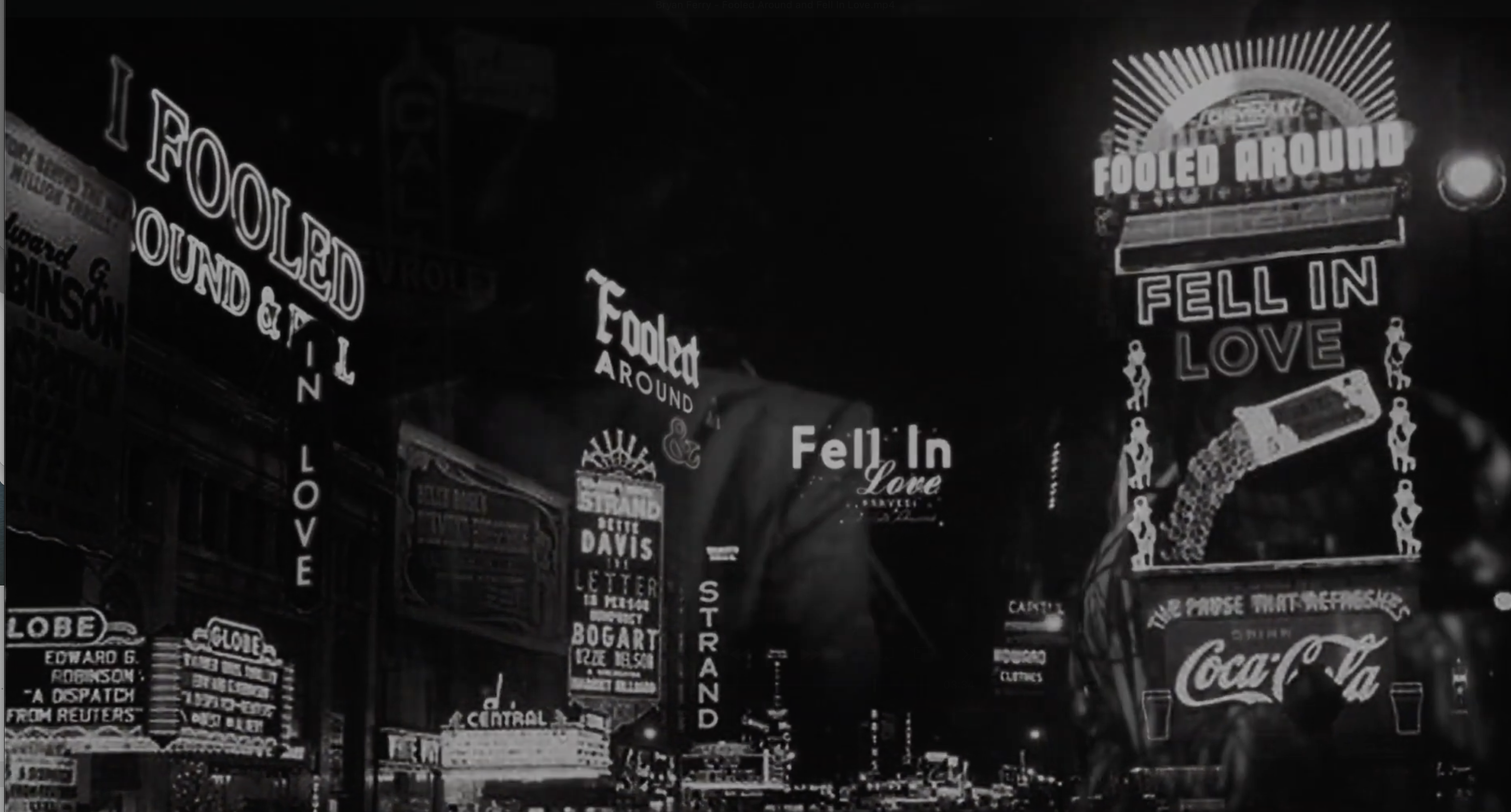
Reading left to right
"I" FOUND &_Fe_e_L
In love
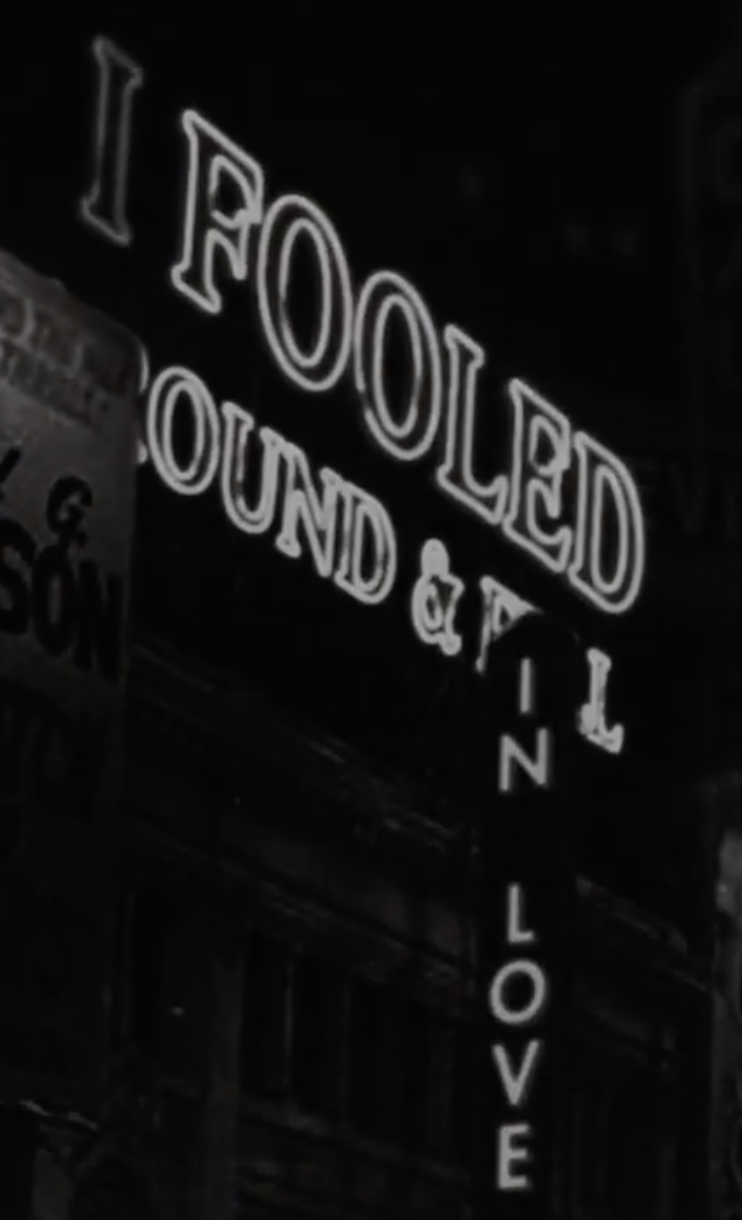
Fooled
AROUND
&
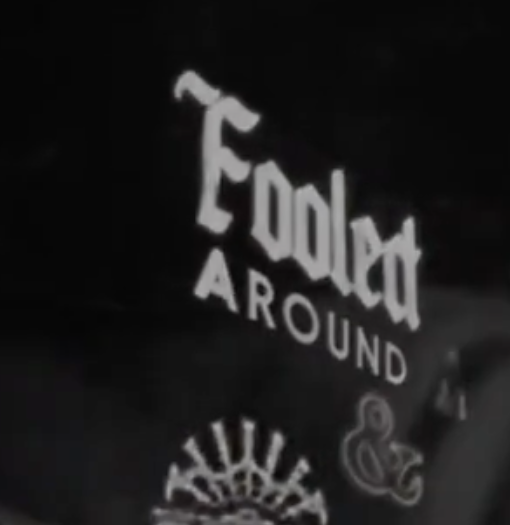
Fell In
LOVE
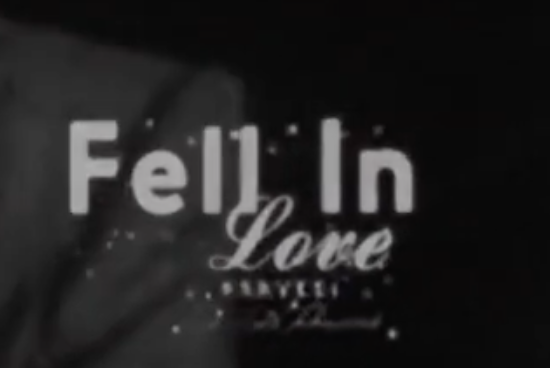
FOOLED AROUND
FELL IN LOVE
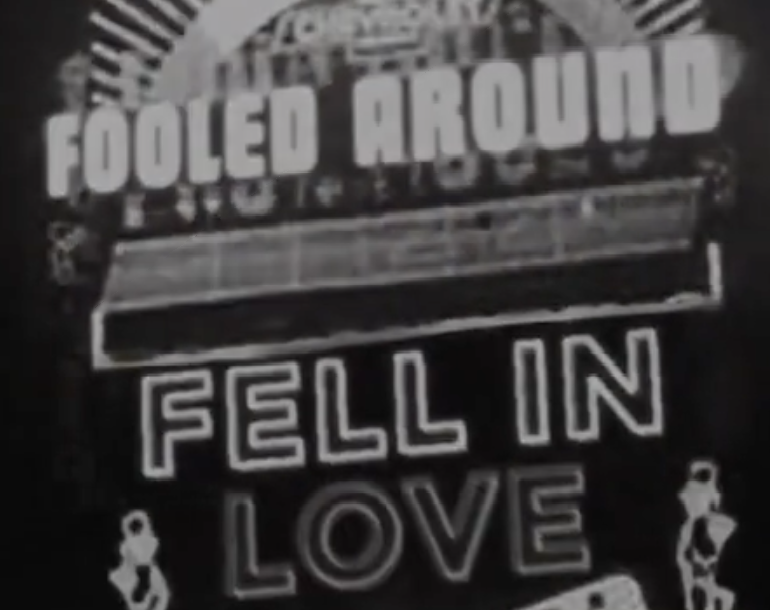
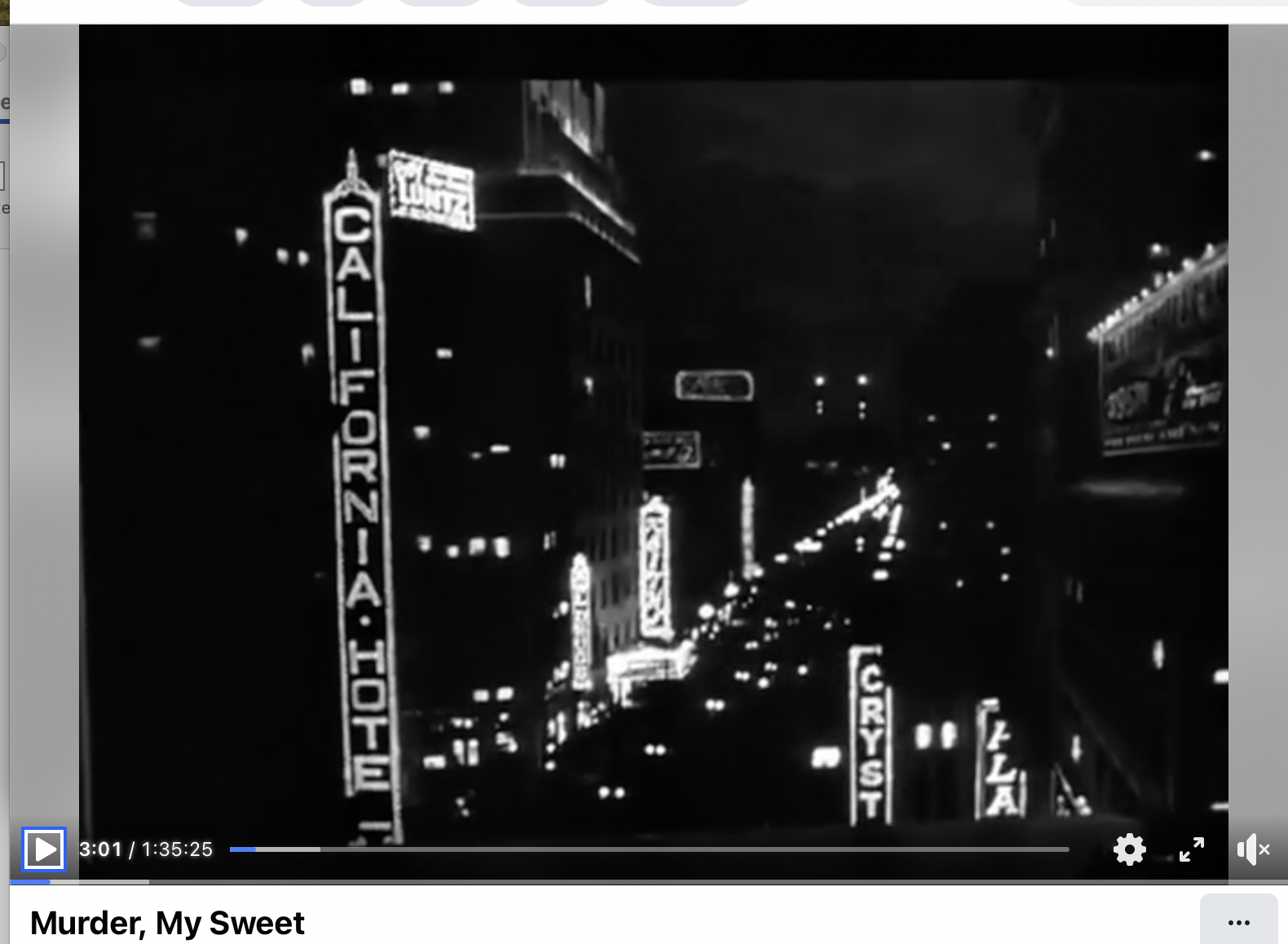

A shot of Dick Powell looking up and seeing Mouse (in the top center of the shot) appear over the location shot from Powell's office.
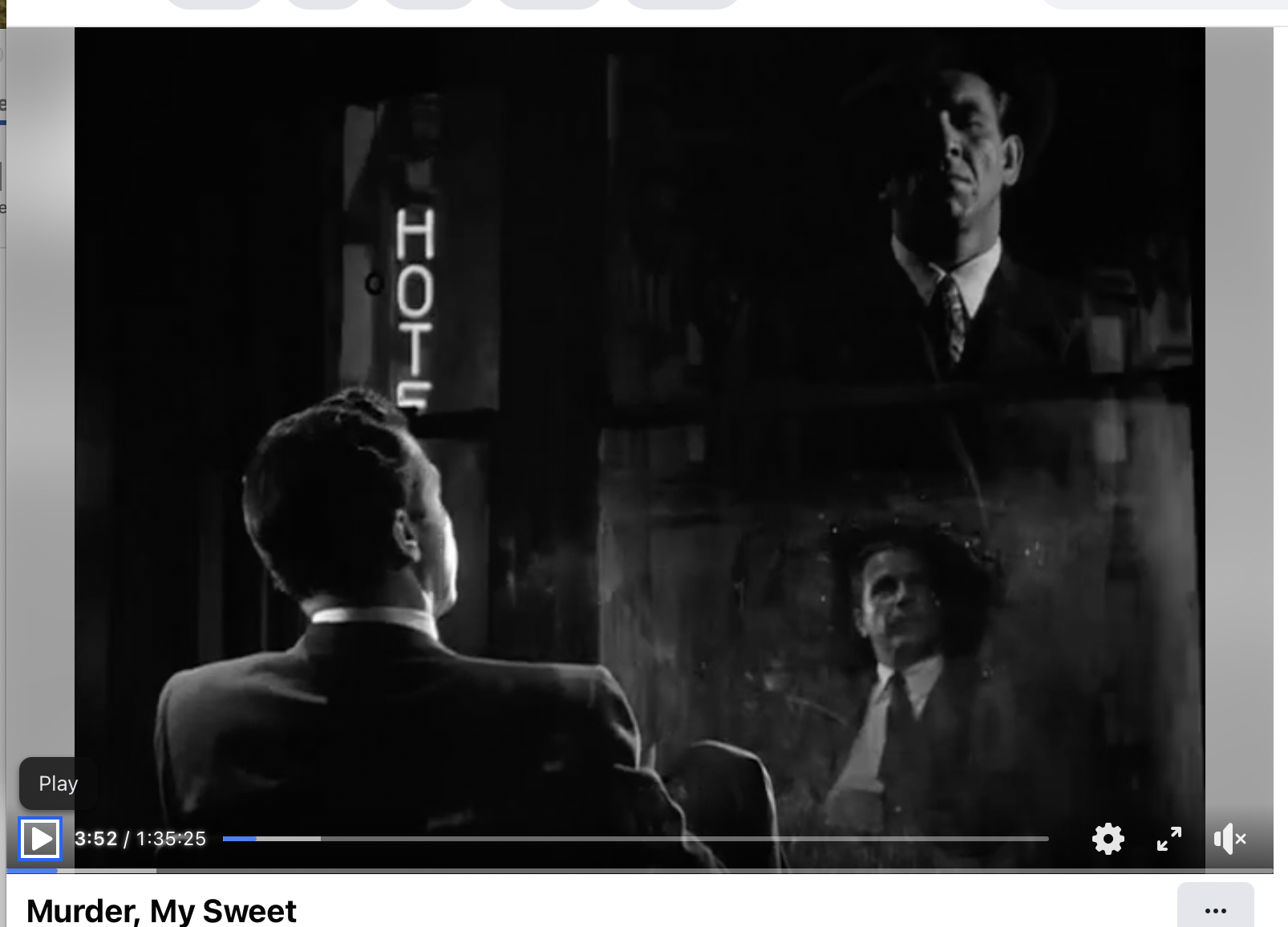
Eva's Hosiery sign
Dissolve location two shots from Murder, My Sweet, one of a neon sign of a low rent bar called Florians (no apostrophe) another of a car speeding down a street past coming closer to the left of the camera.The music video merges two different shots from Murder, My Sweet, one with a car speeding by and the other with the neon sign of a bar named Florians. The Florians shot omes a few minutes later.

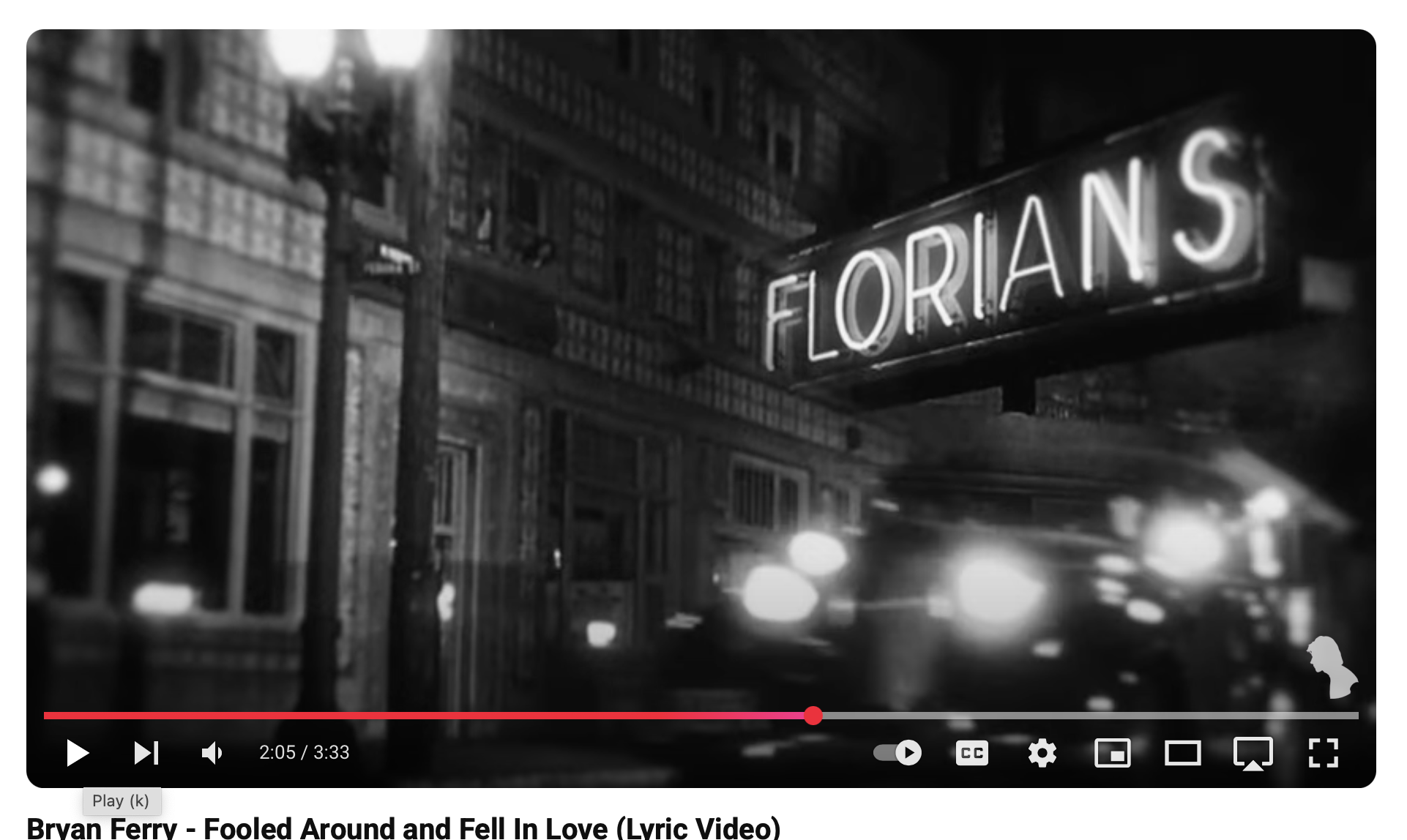

The first shot:
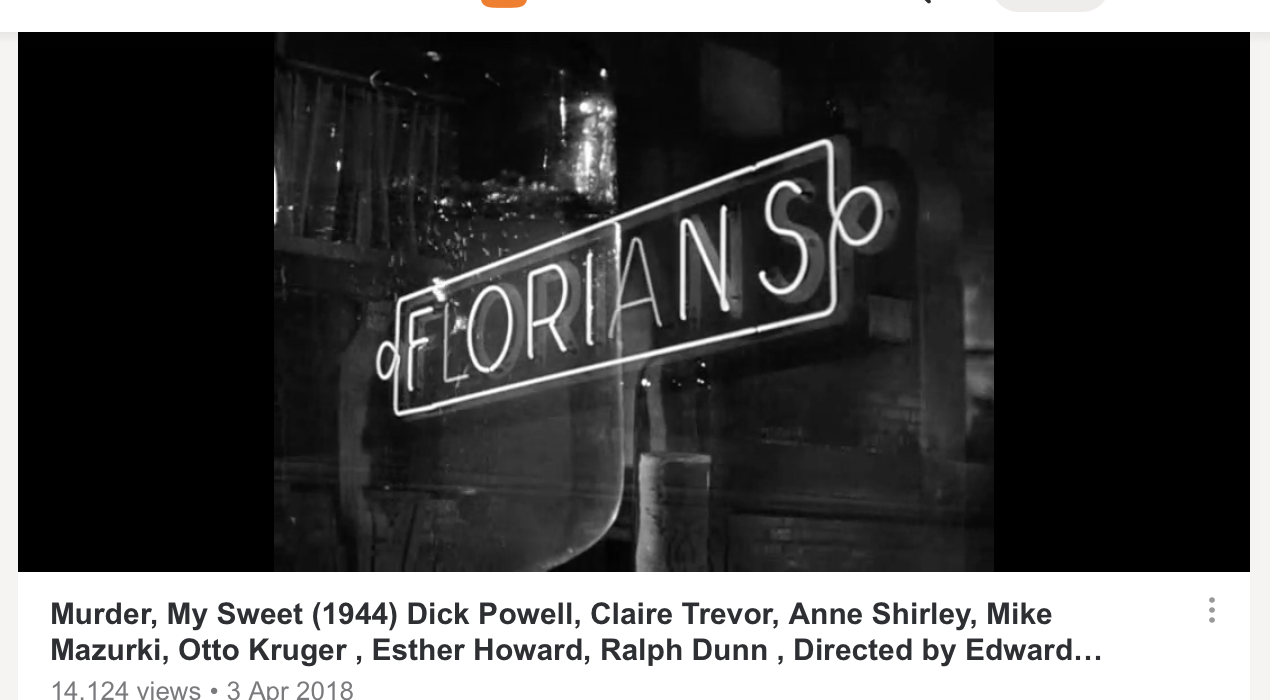
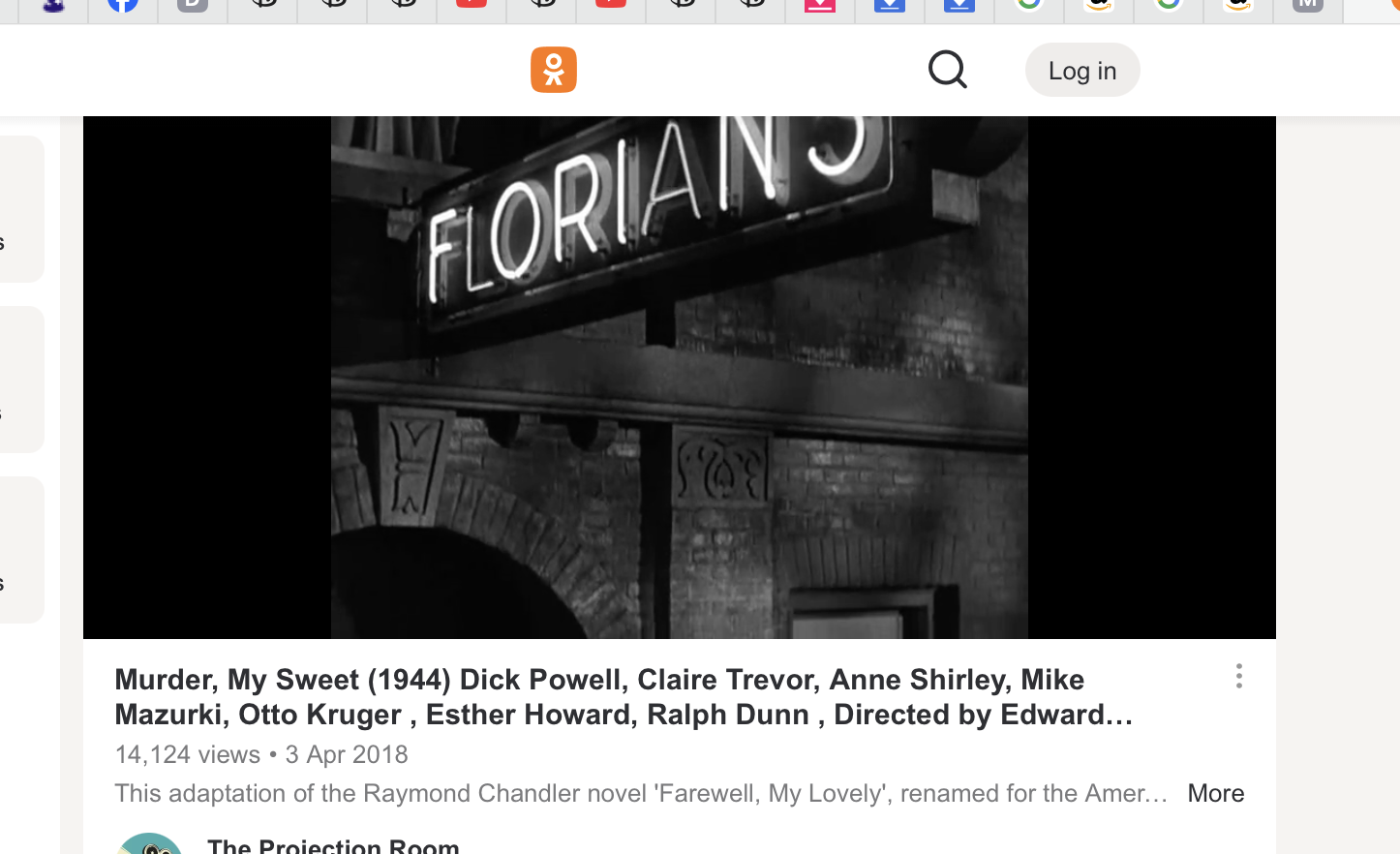
The other shot: a car driving down a road beginning with a dissolve from the preceeding shot.
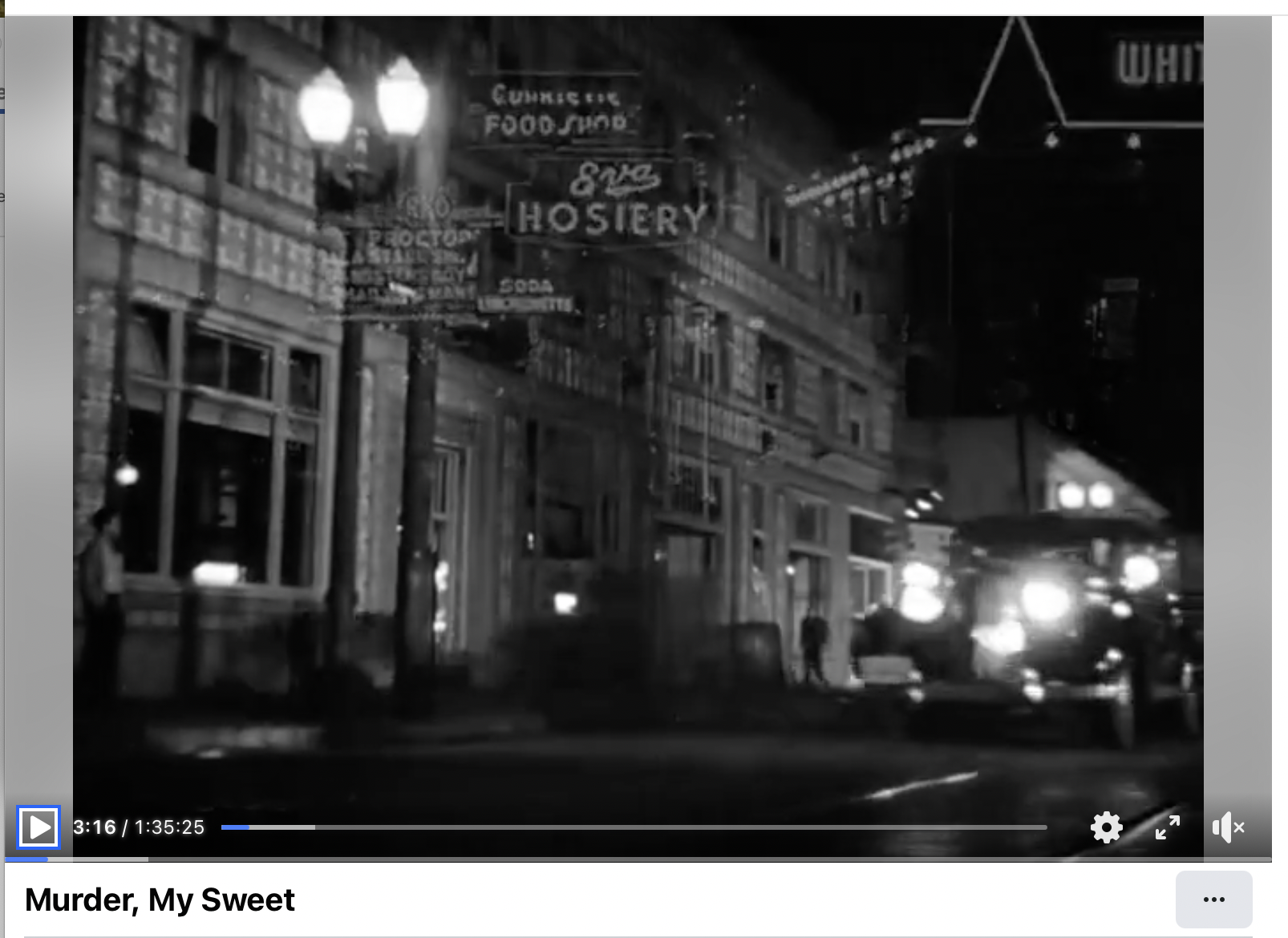
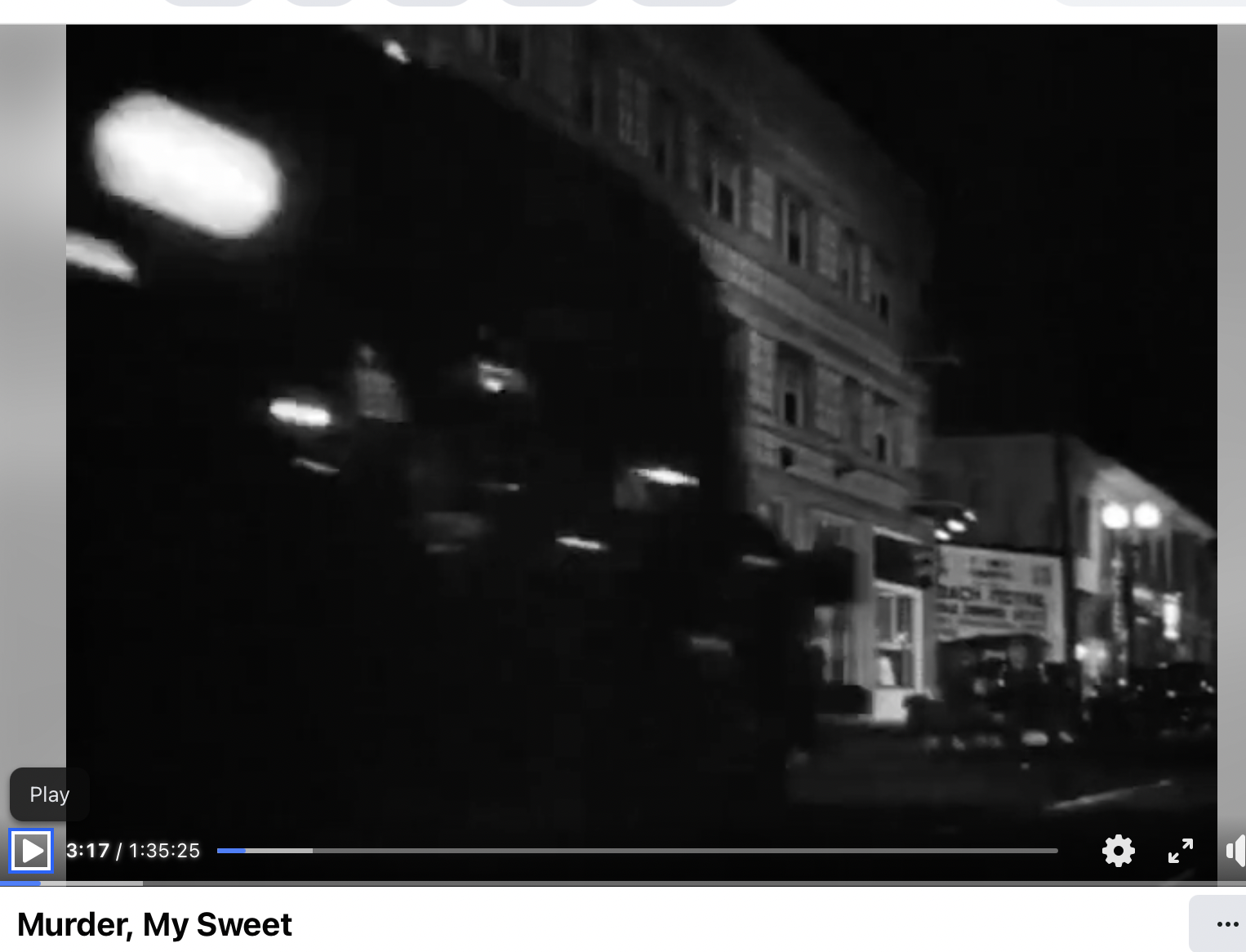
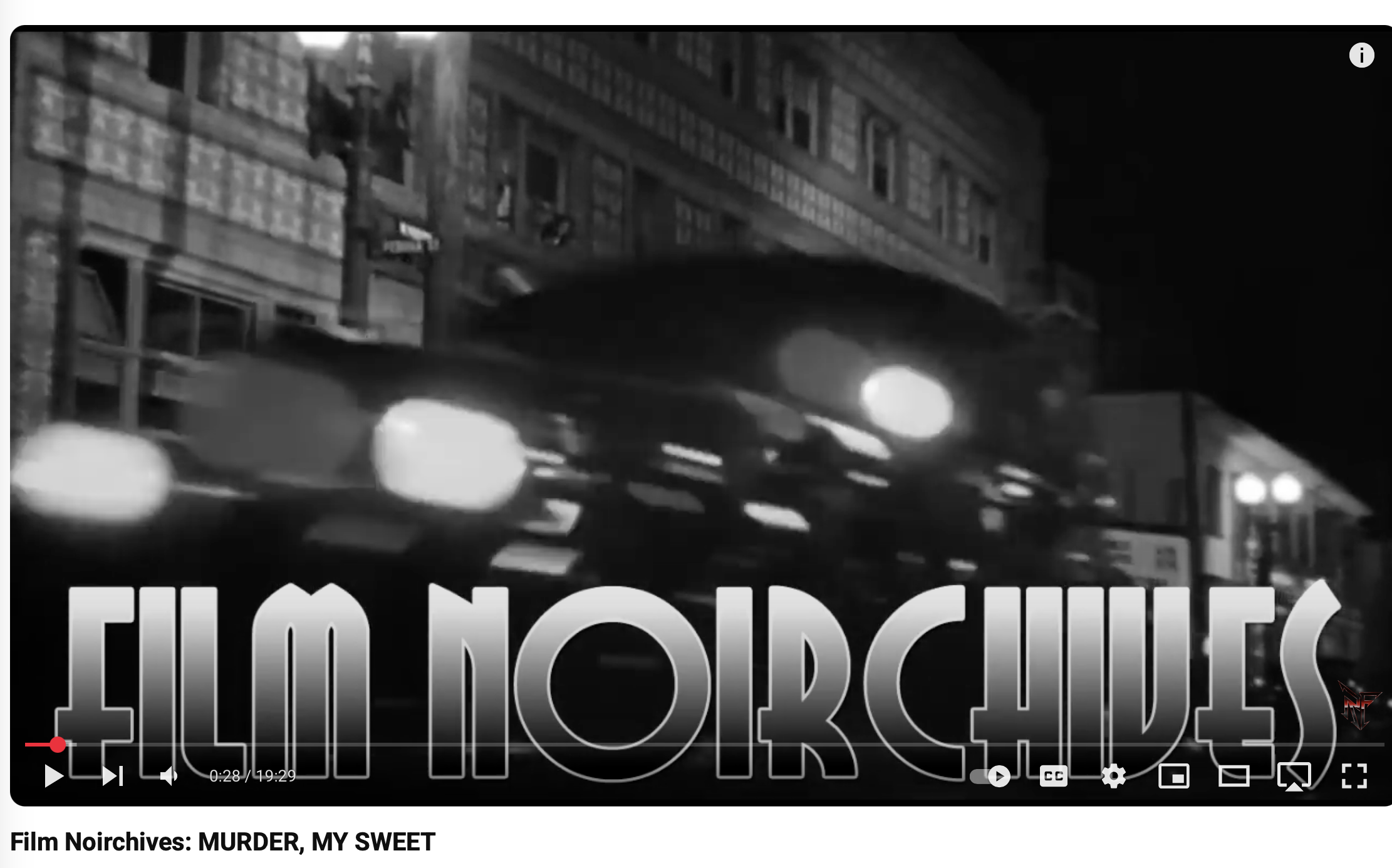
https://m.ok.ru/video/654665583344
Four shots from Out of the Past appear, one at a same time.
The second shot , on the left, Jeff walks through revolving doors and stops just in front of the directory on the wall behind him; on the left side of the frame, is of Mitchum breaking and entering a door to an apartment.

To thelower right is a shot of Mitchum kissing his girl as he says goodbye with the officer location shot dimmed.
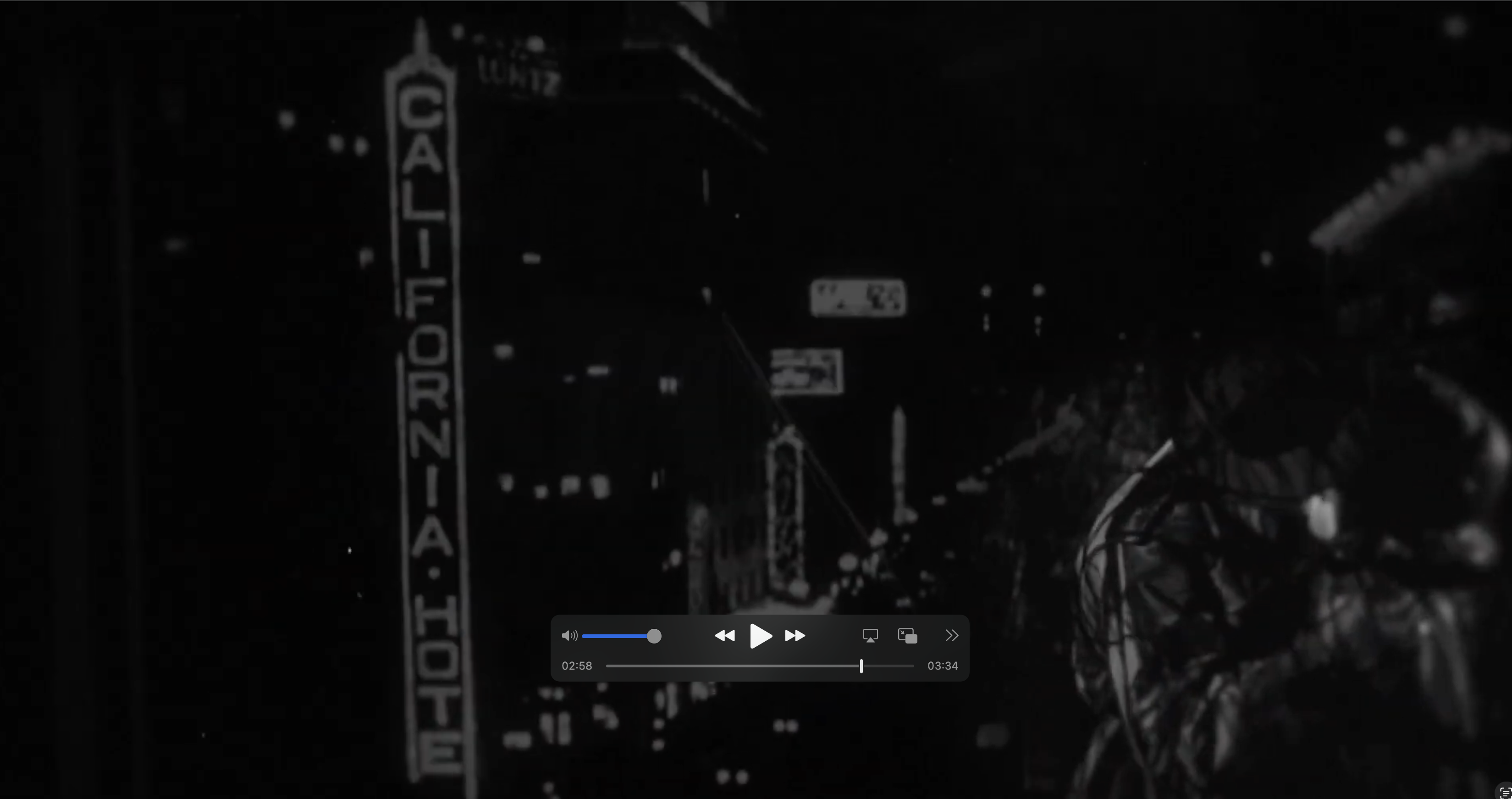
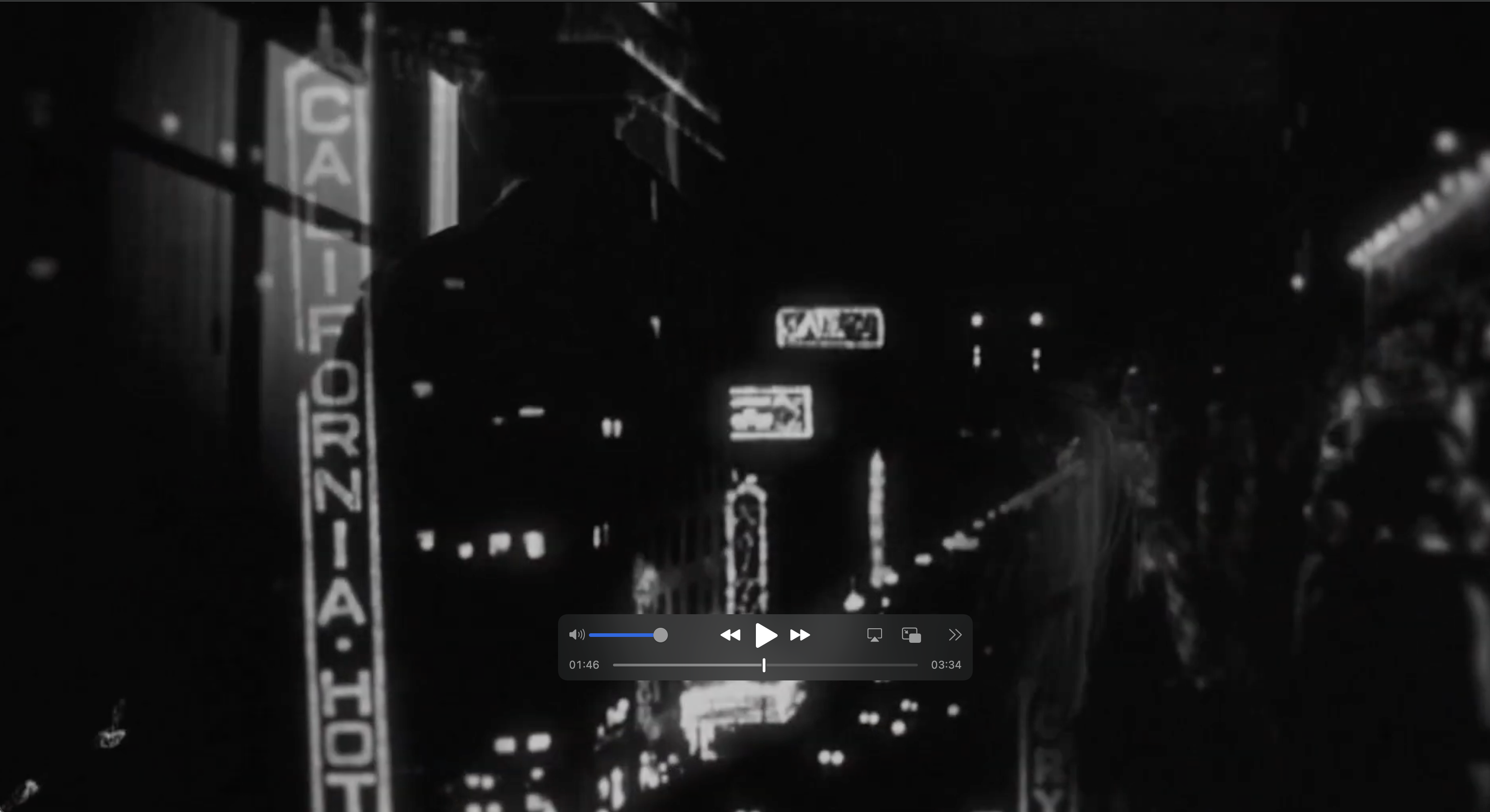
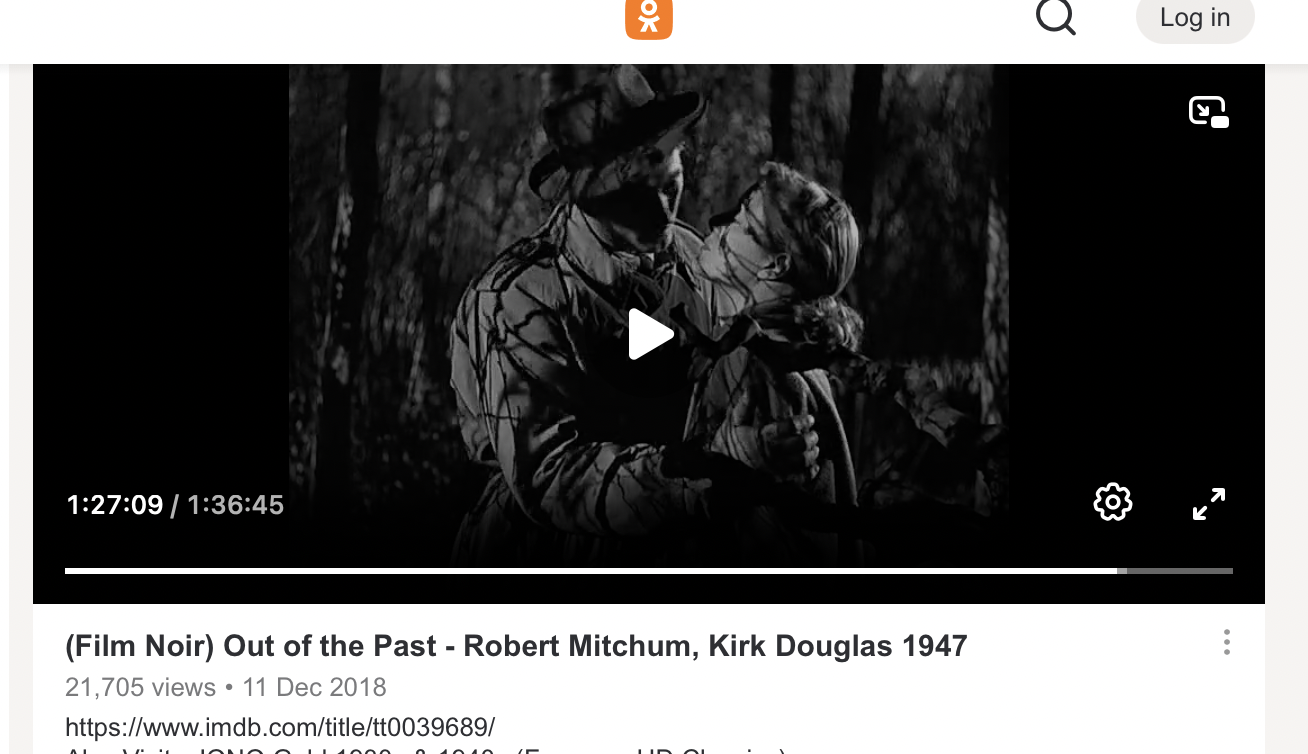
As Mitchum goes through the door, he starts to come into frame on the right entering through a revolving door.
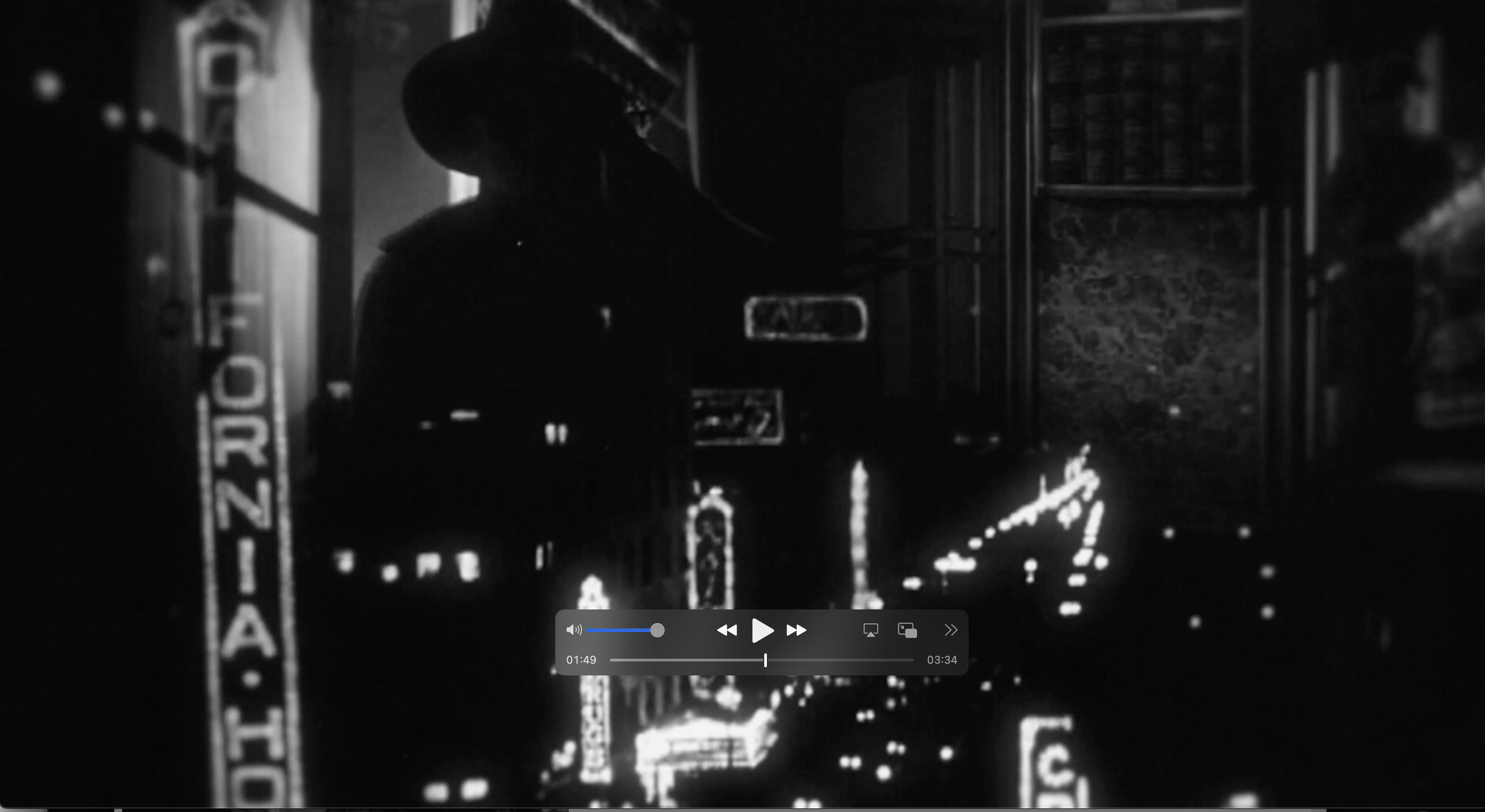

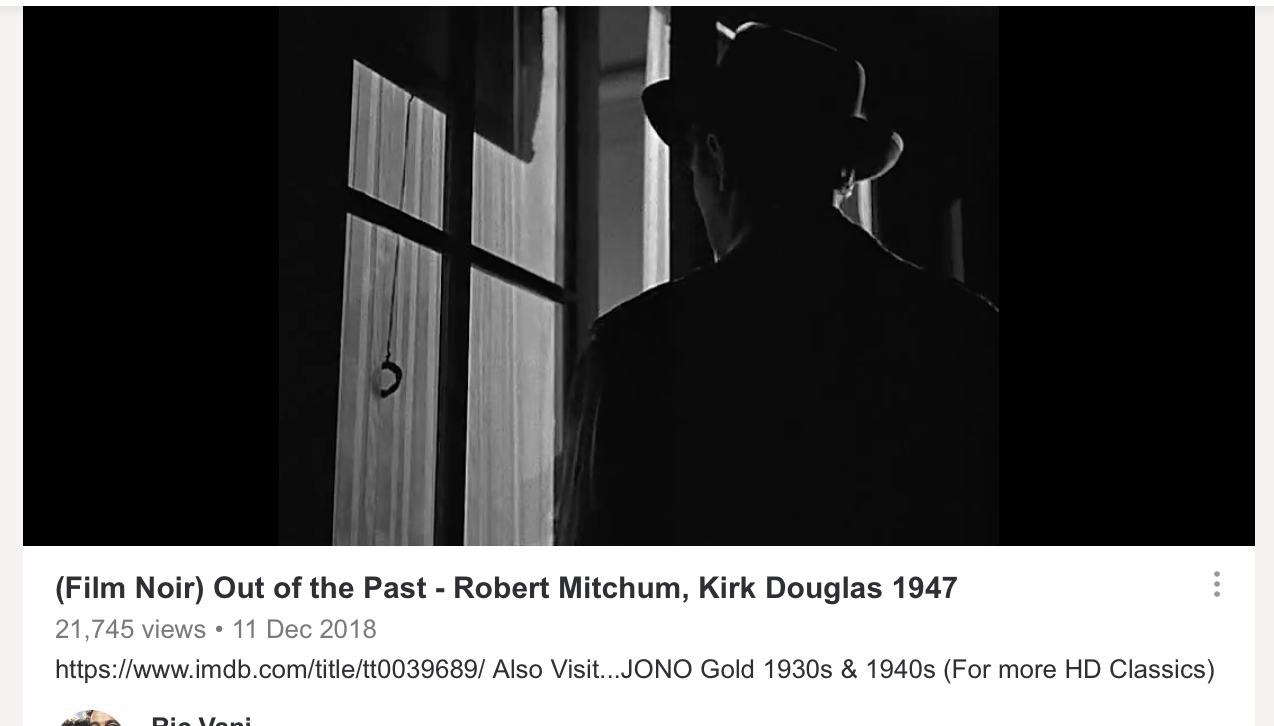
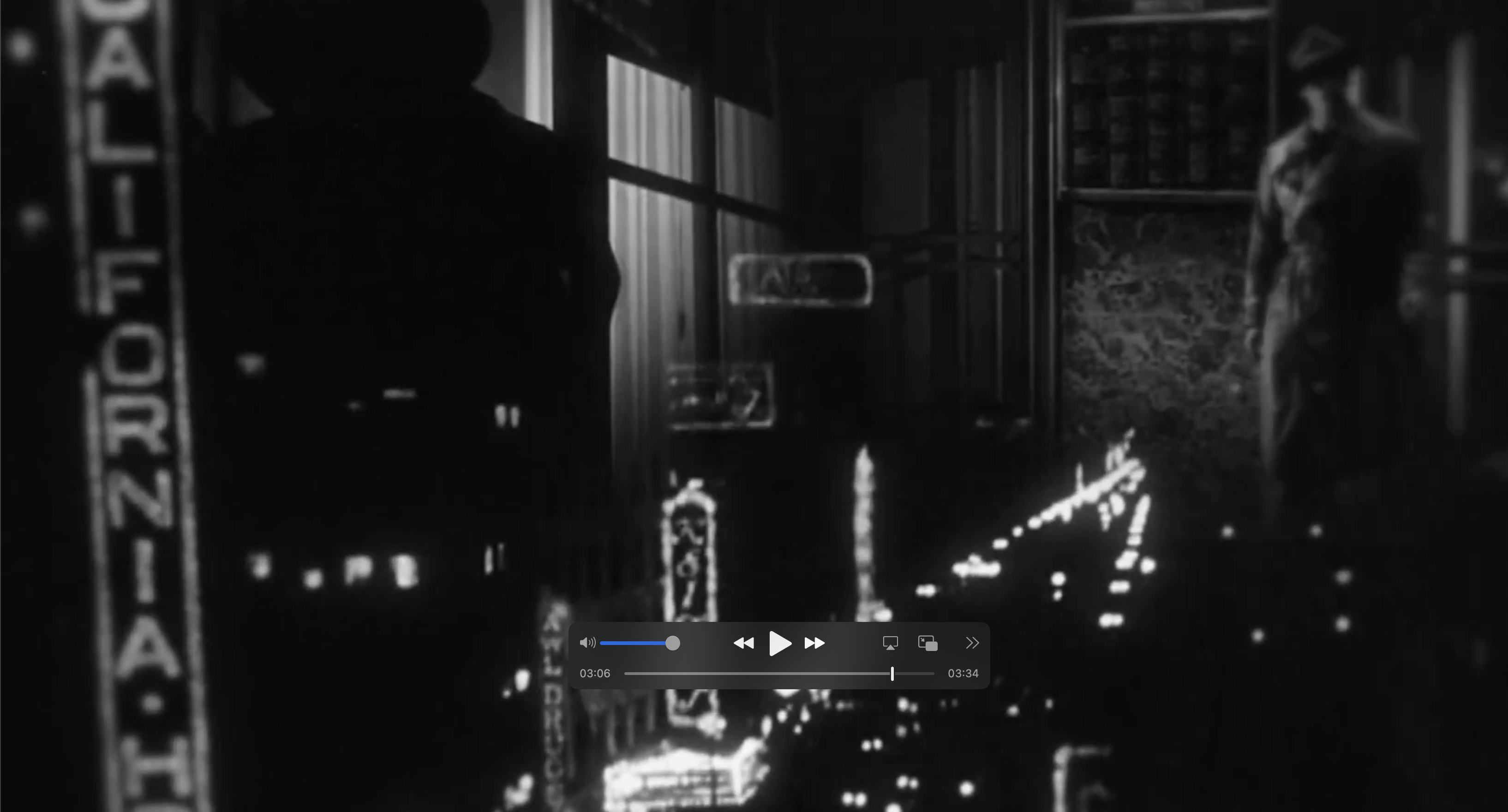
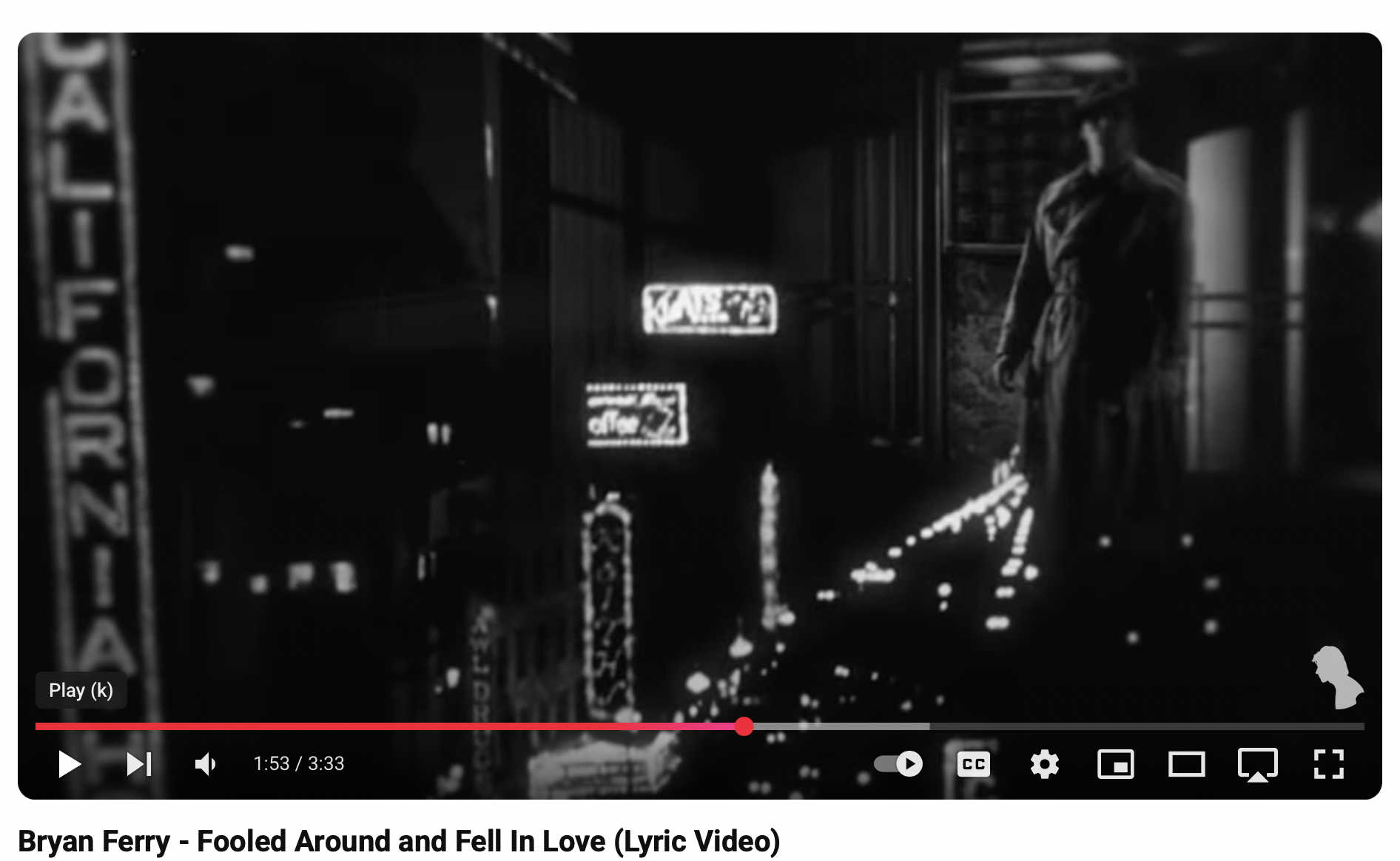
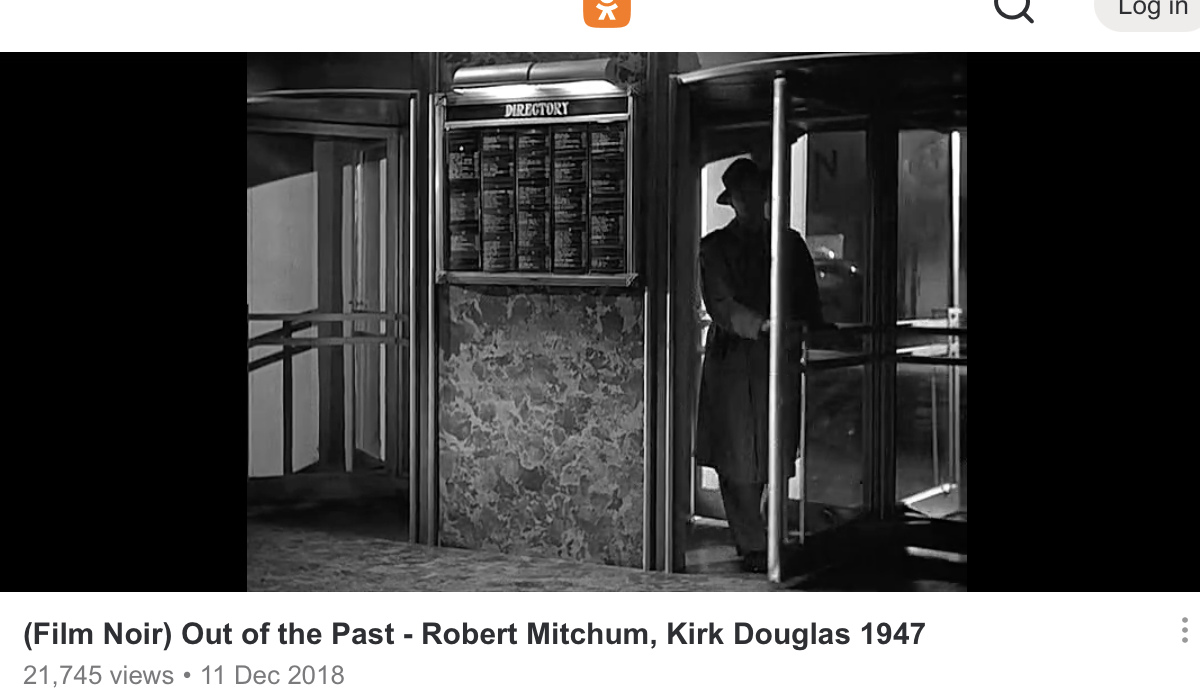
When has entered the mason building, Cathy starts to walk out of it in the lower left.
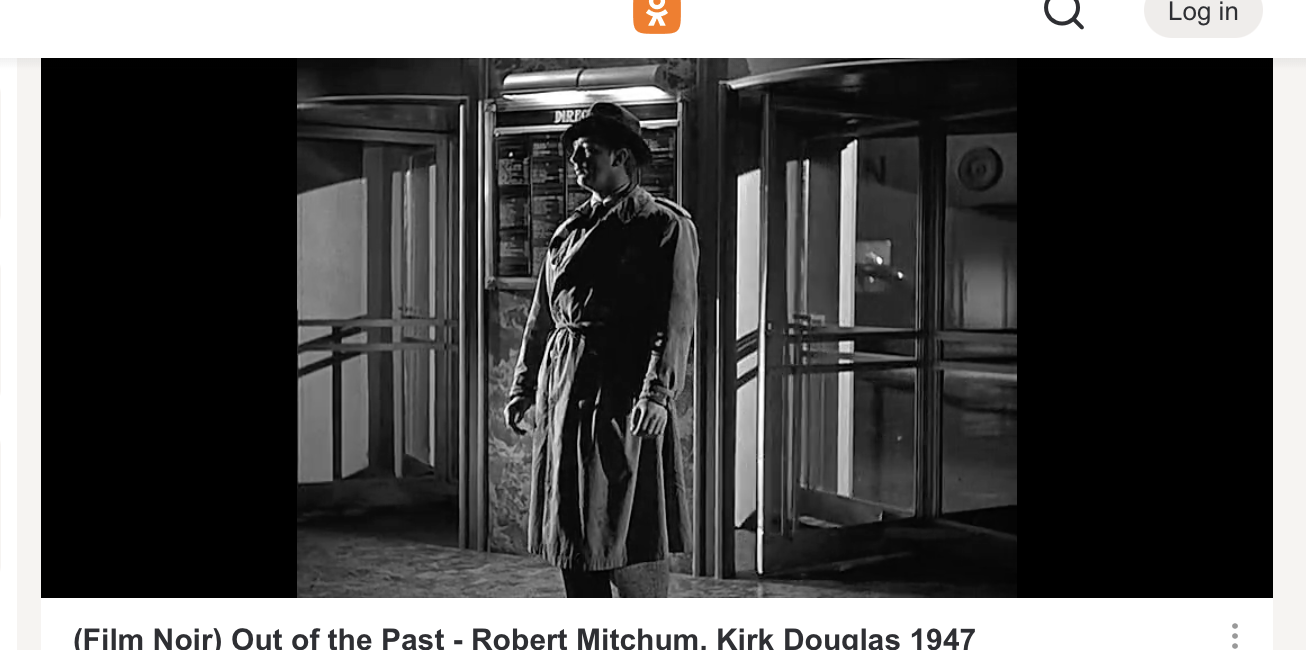
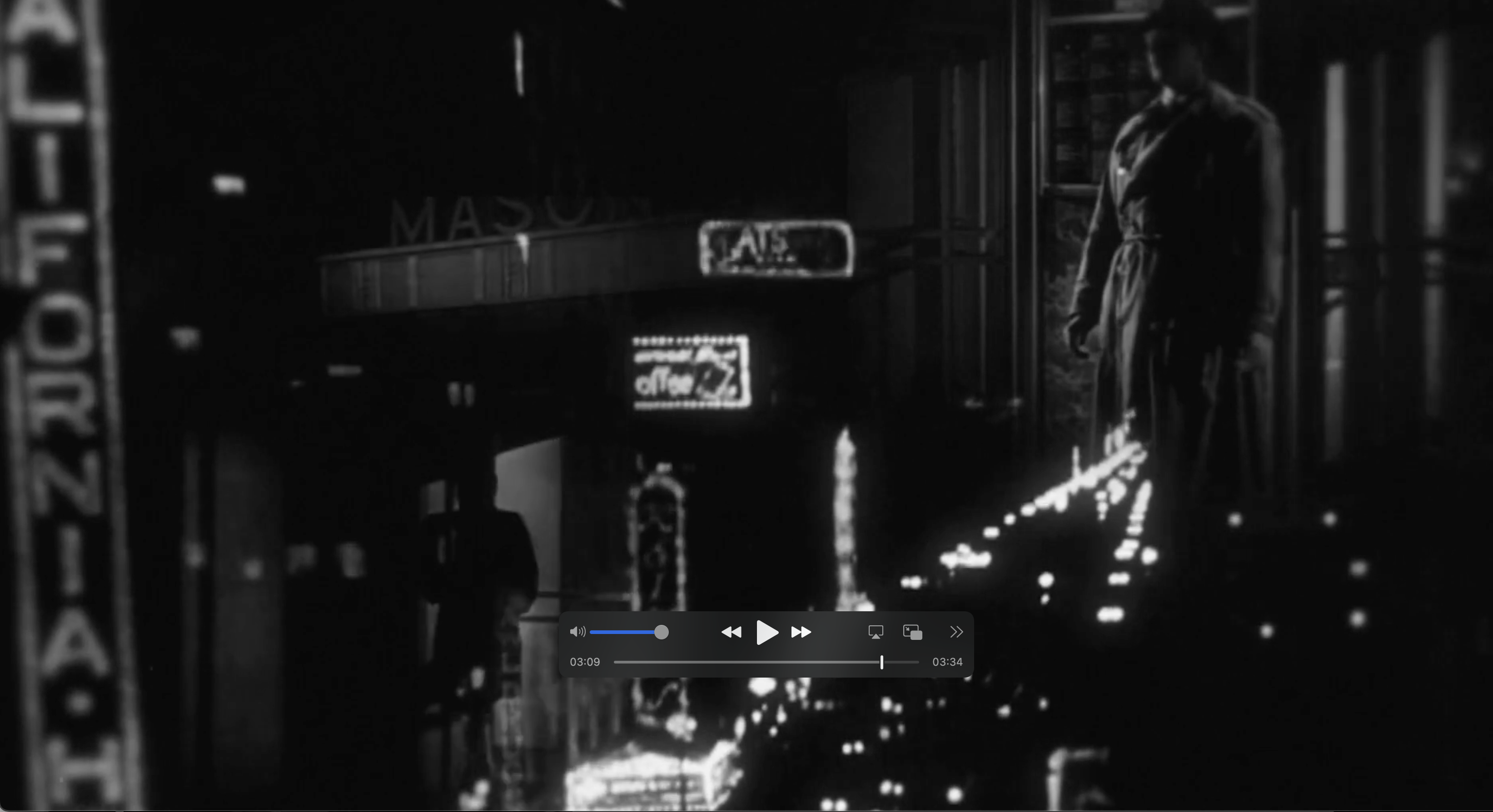
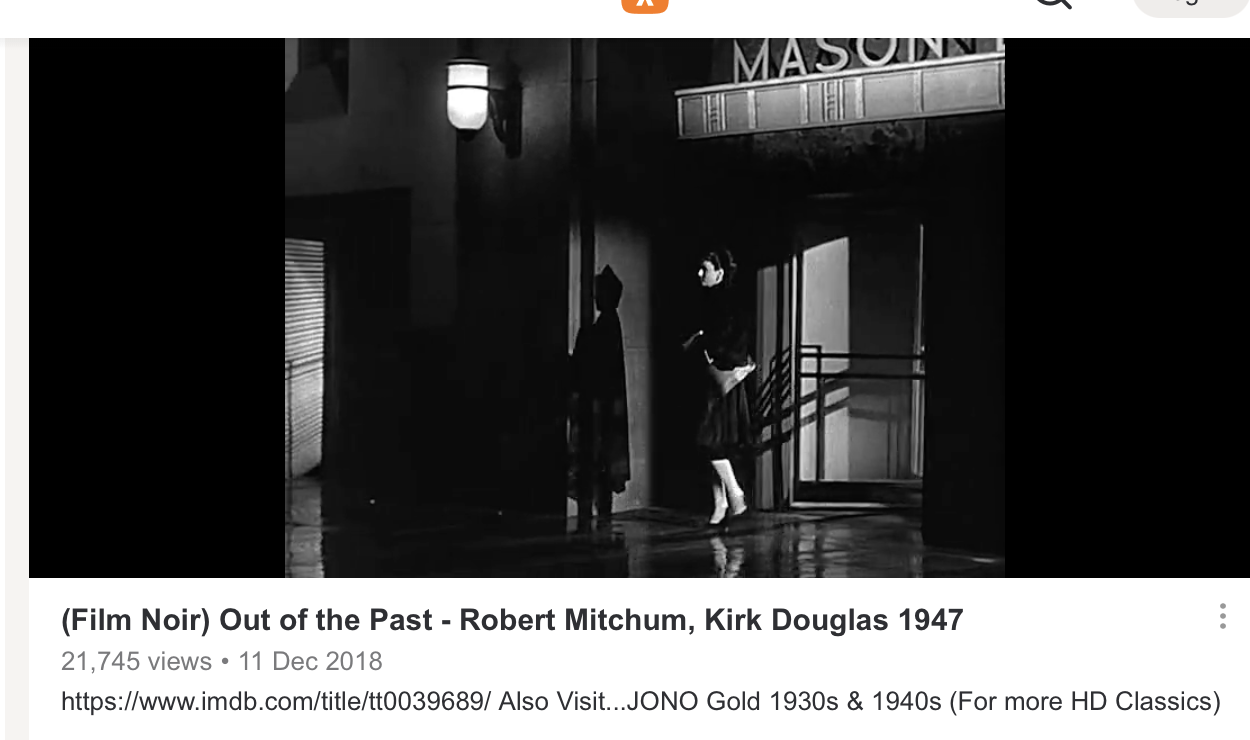
Jeff is about to looking at the directory for a CPA named Eels (rhymes with heels?).
(The shot below is not in the video.)
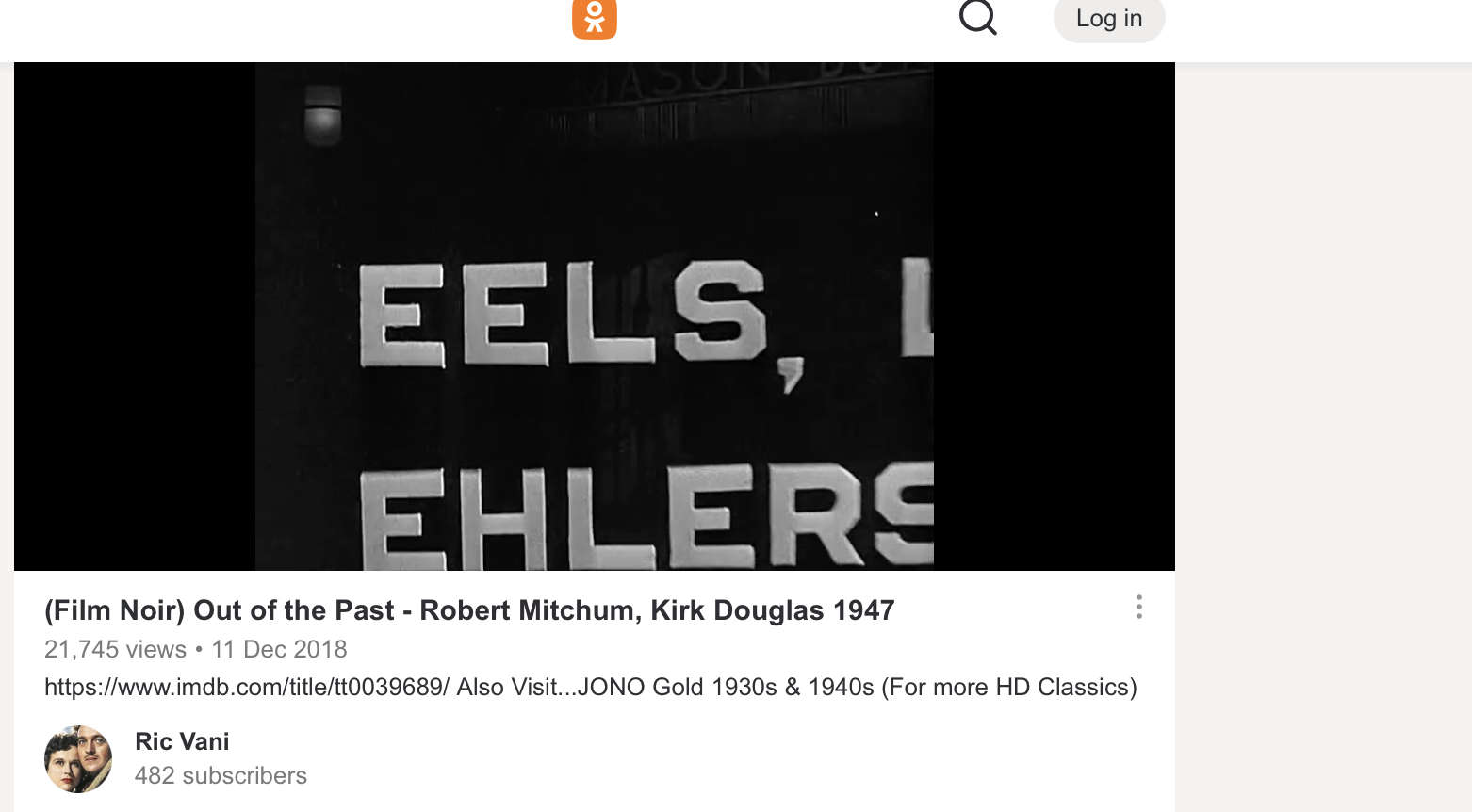
The shot of Graham dancing from Crossfire continues as a new shot from the Killers of the men appears in the lower right corner.
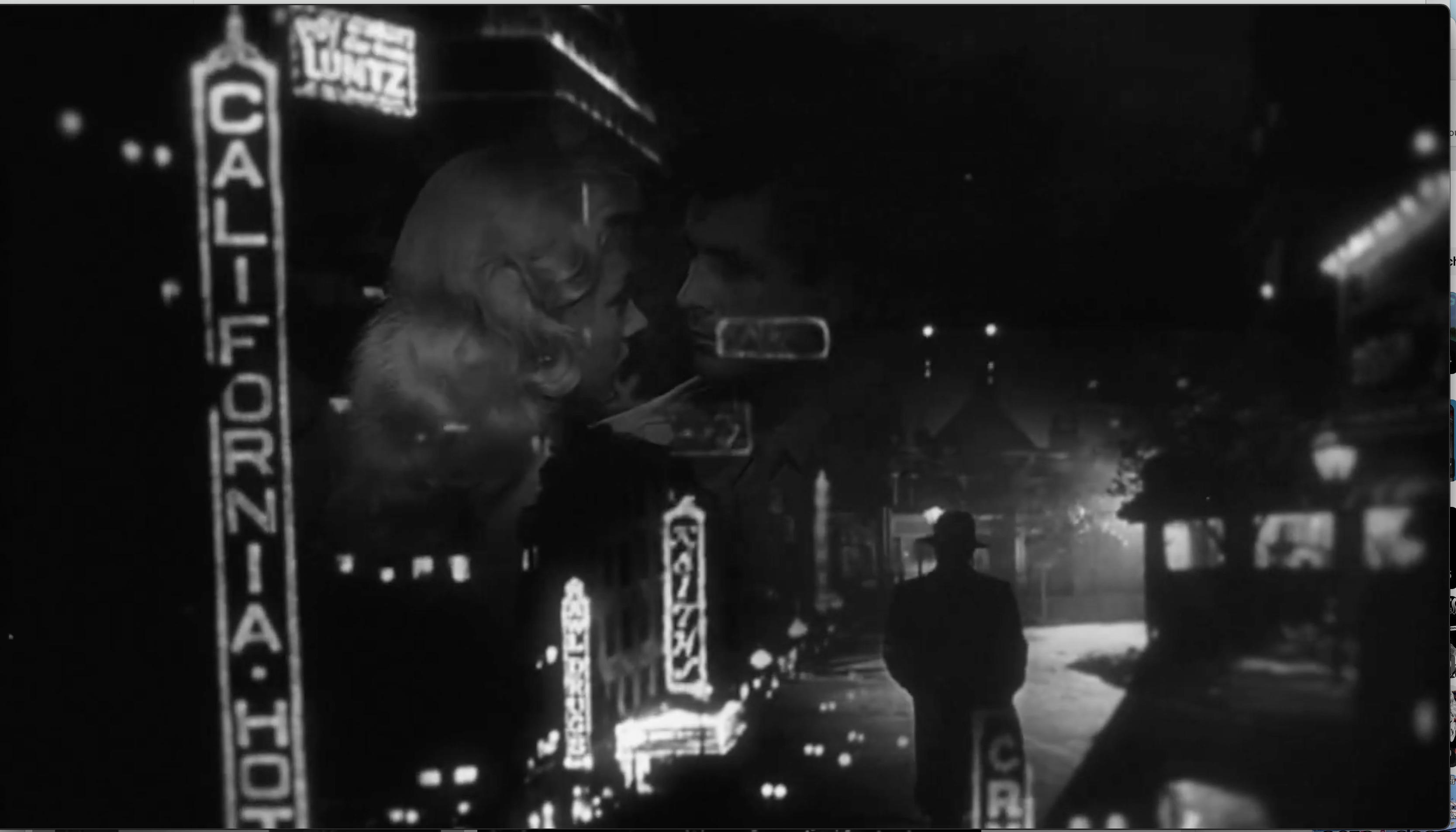
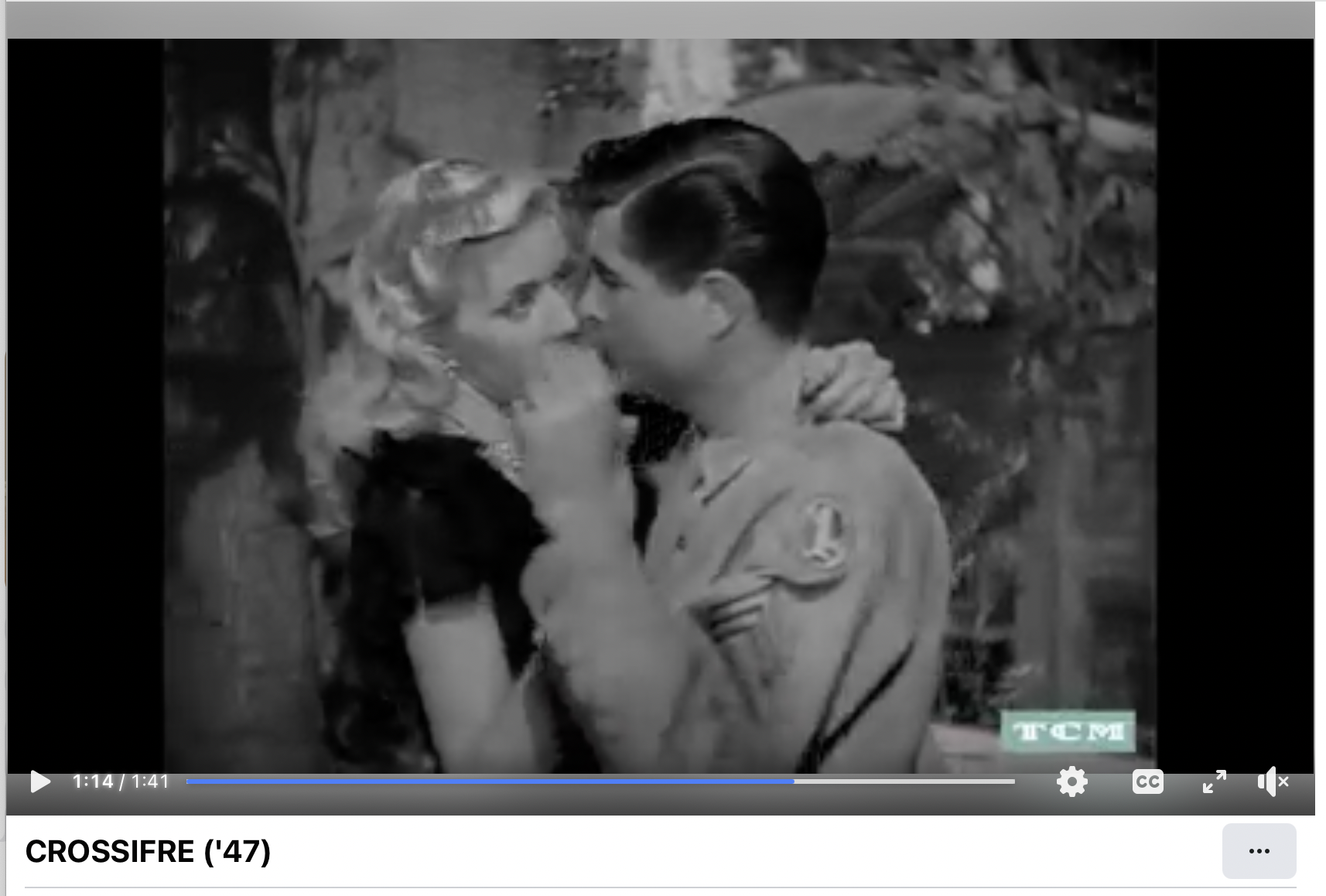
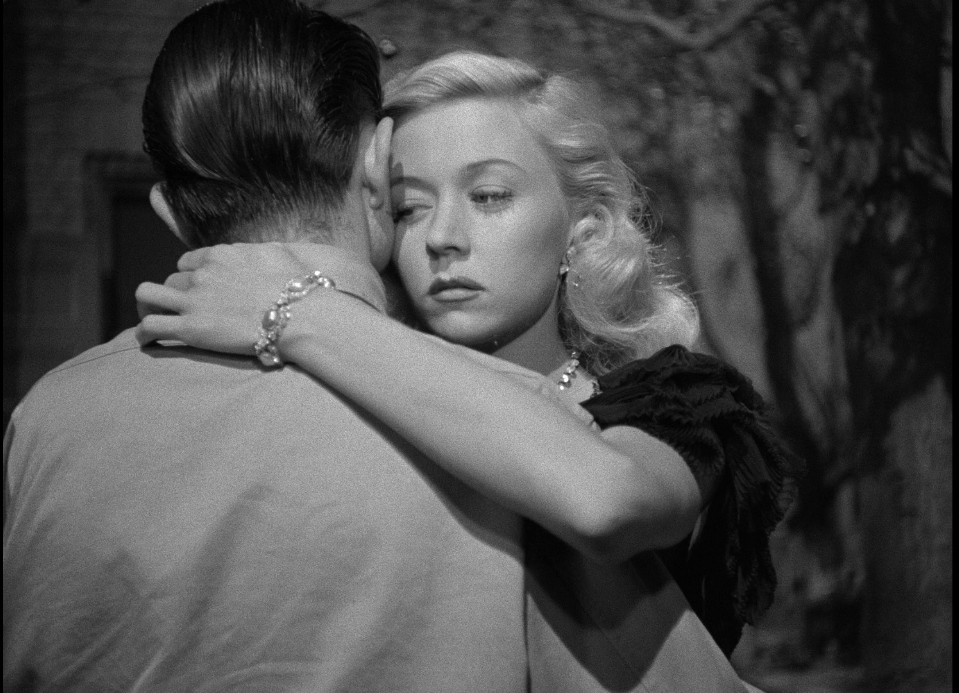


Ava gardner's face appears in the upper right, opposite Kitty. Kitty fades out. And she then fades out.
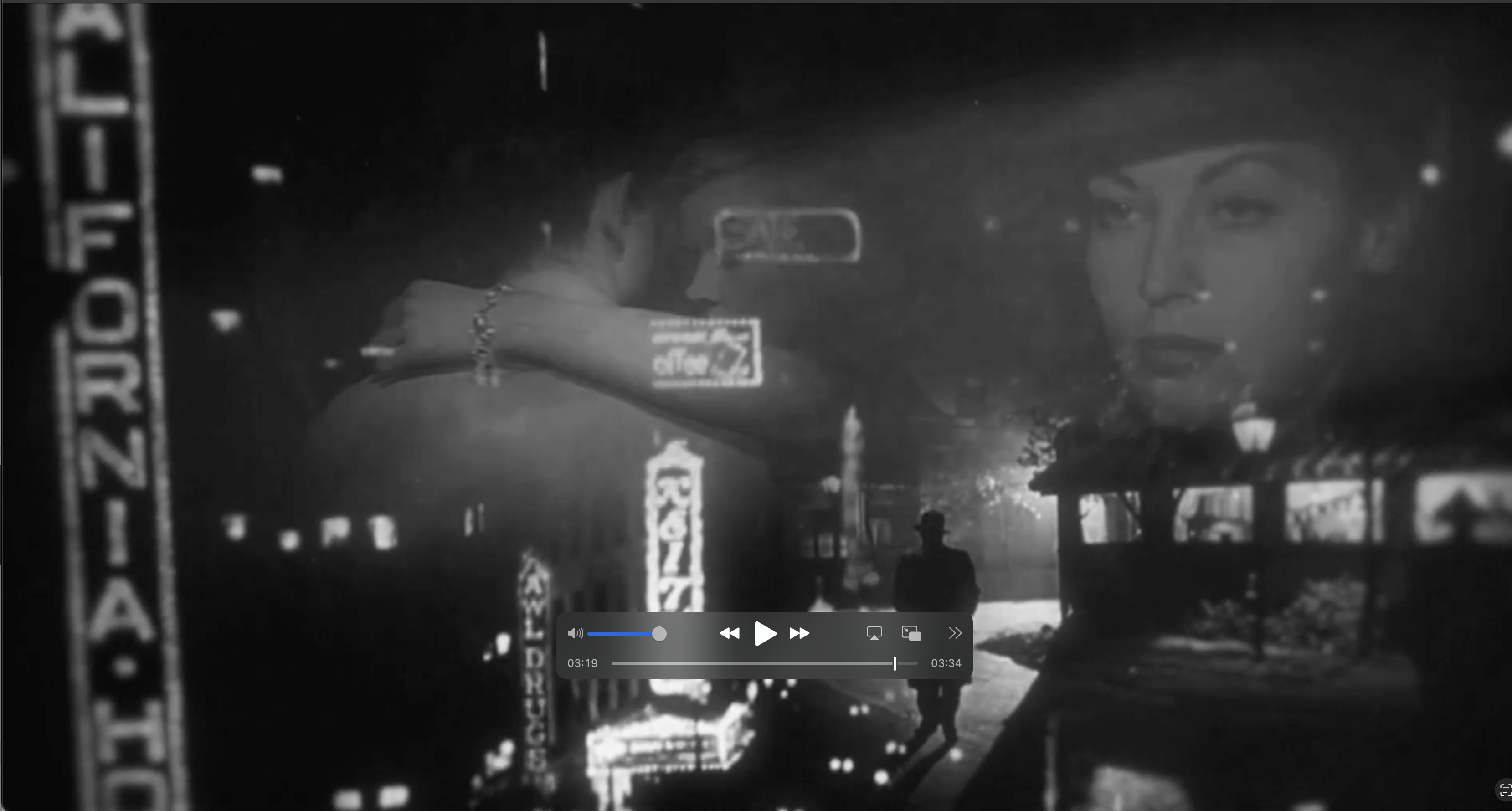
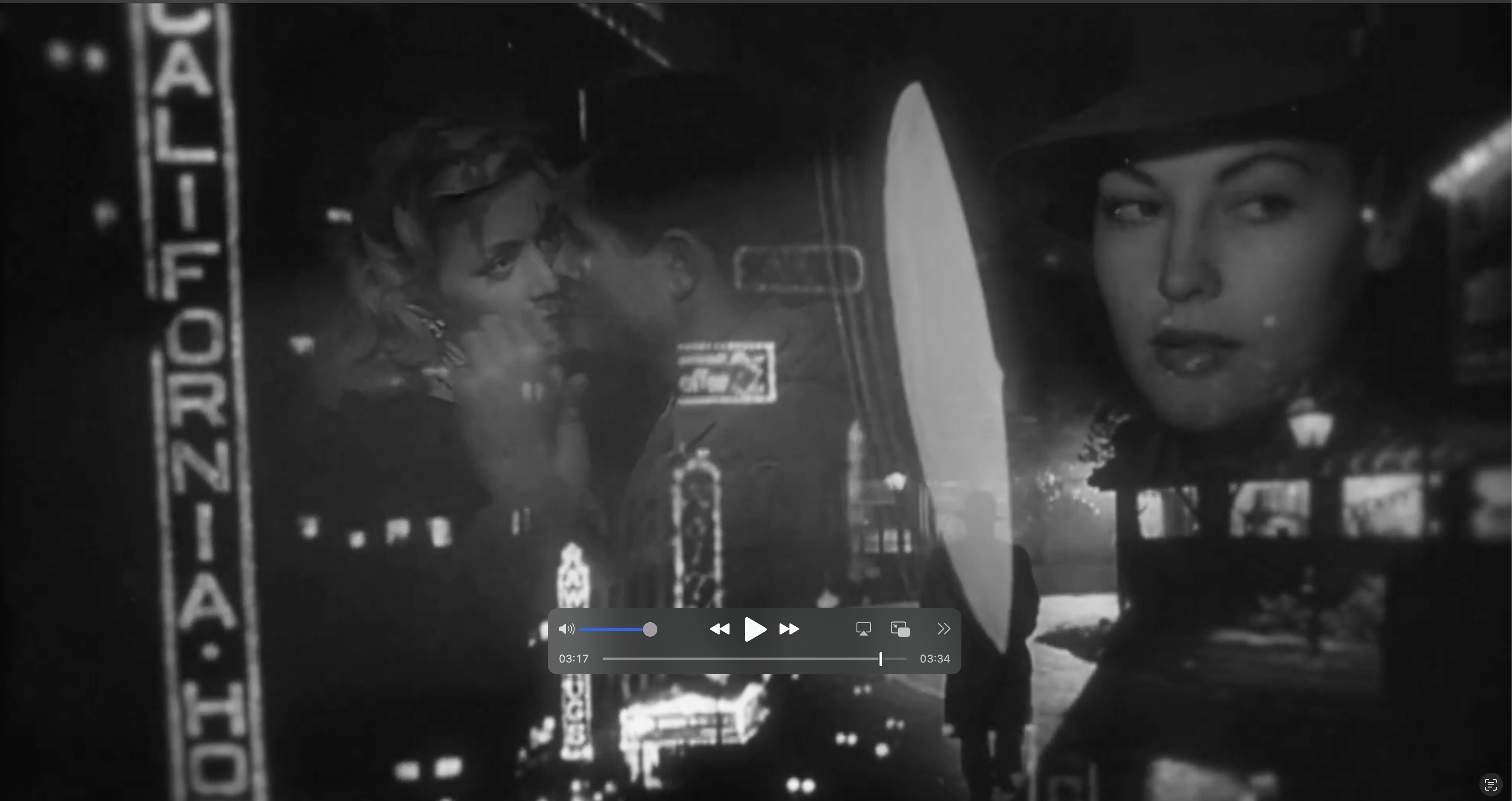
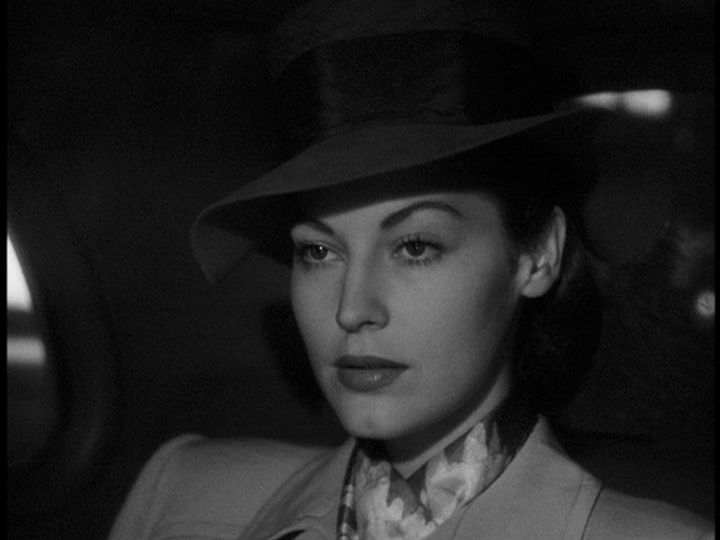
After she fades out a shot of Edmund O'Brien replaces the shot of Graham in the upper left continues a shot of a taxi driving displaces the shot of the hitmen. O'Brien and Gardner are abobut to get out of the taxi and go to the bar.
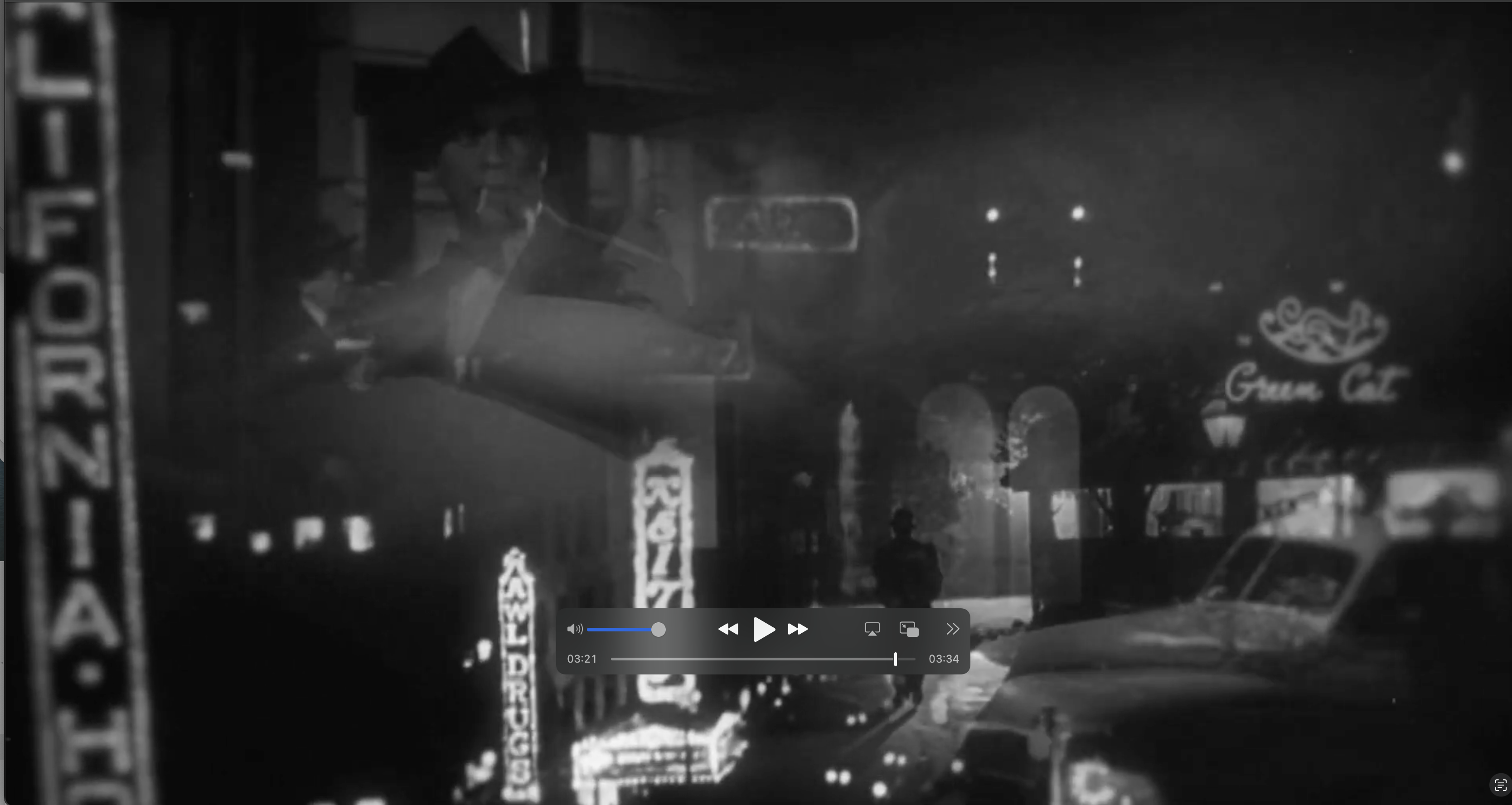

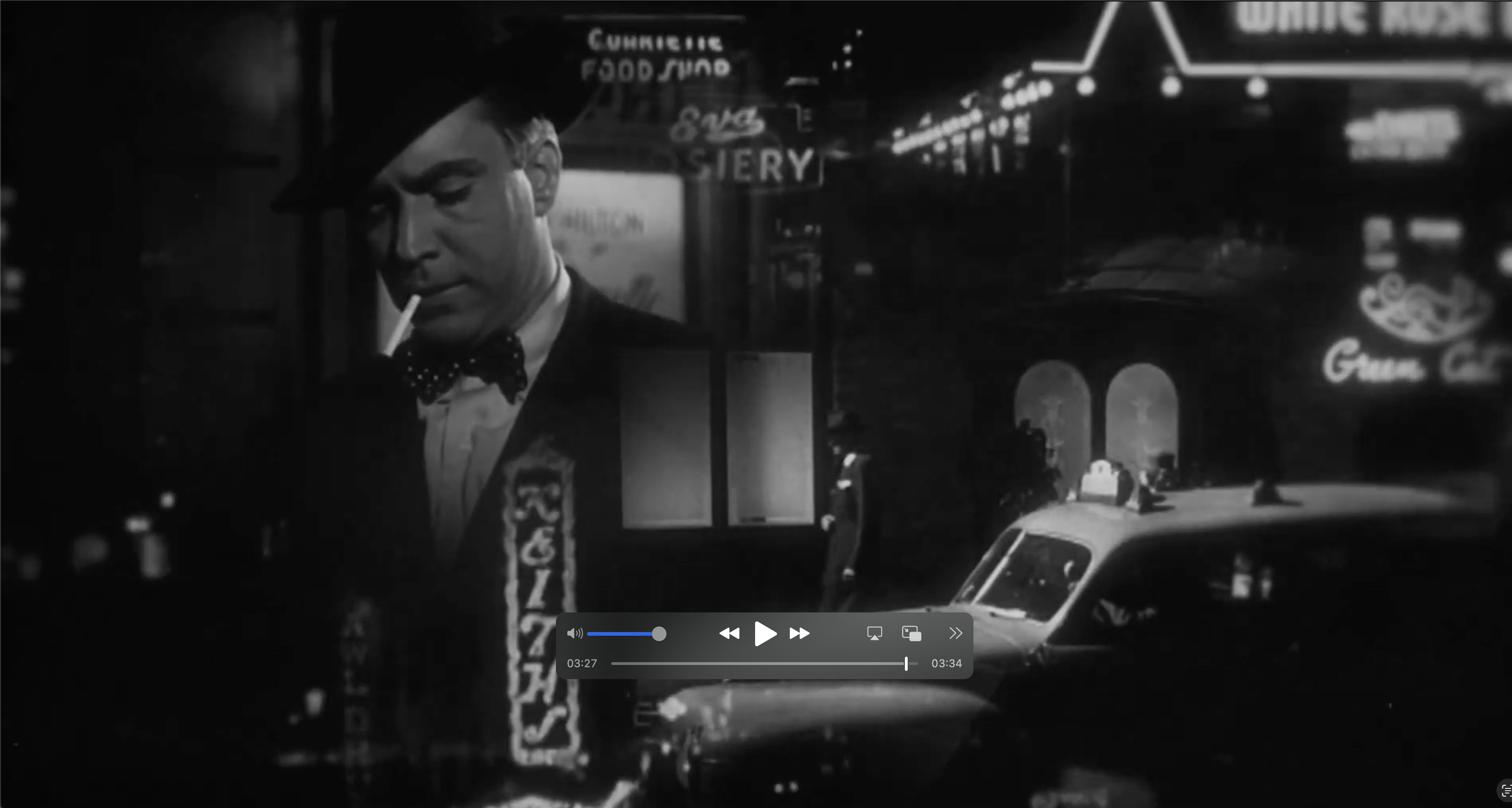
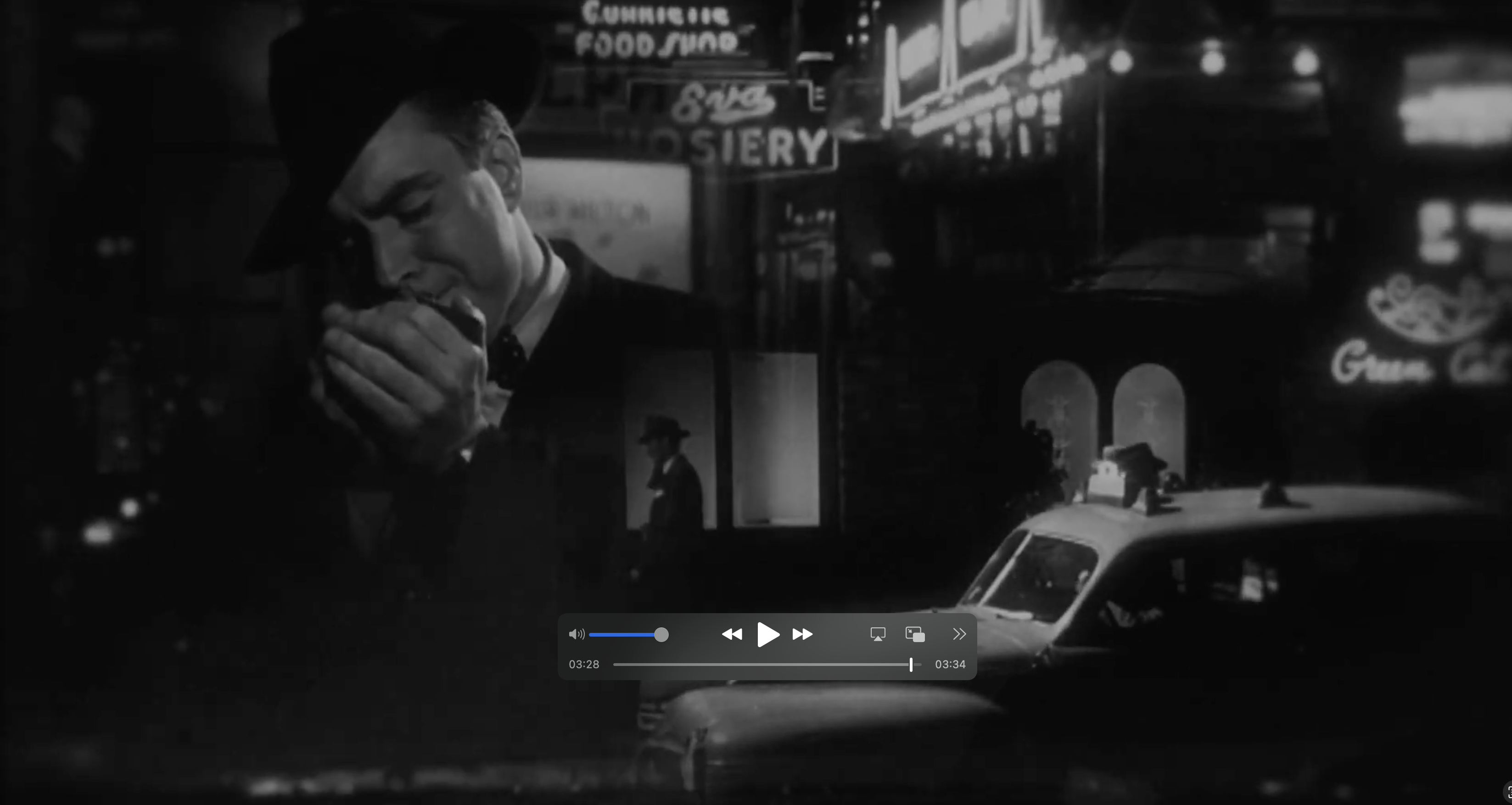
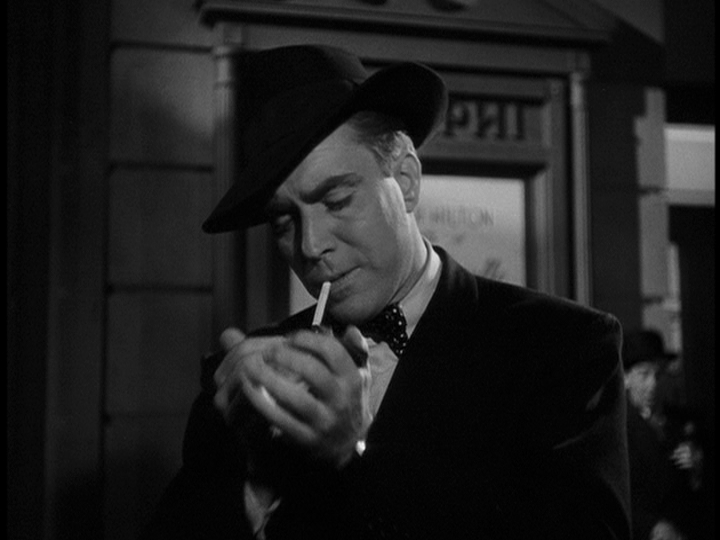
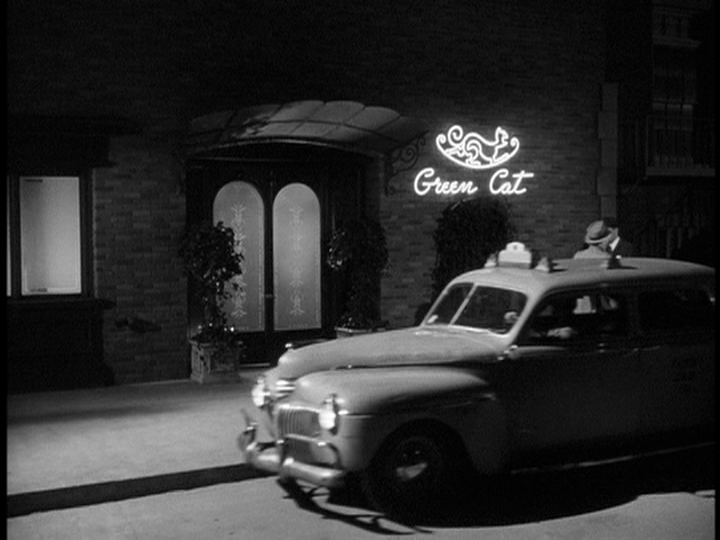
Film titles and stars on movie marquees. These titles reframe the untitled film noir excerpts. What kinds of film genres can noirs be said to have encompassed (screwball comedy, melodrama, bipic?) and how far back in time does the coverage of htese genres go?
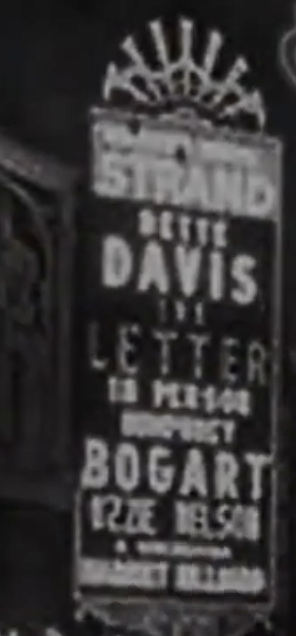
The Letter (1940 film)
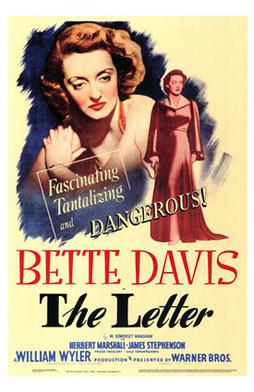
Click on photo above.
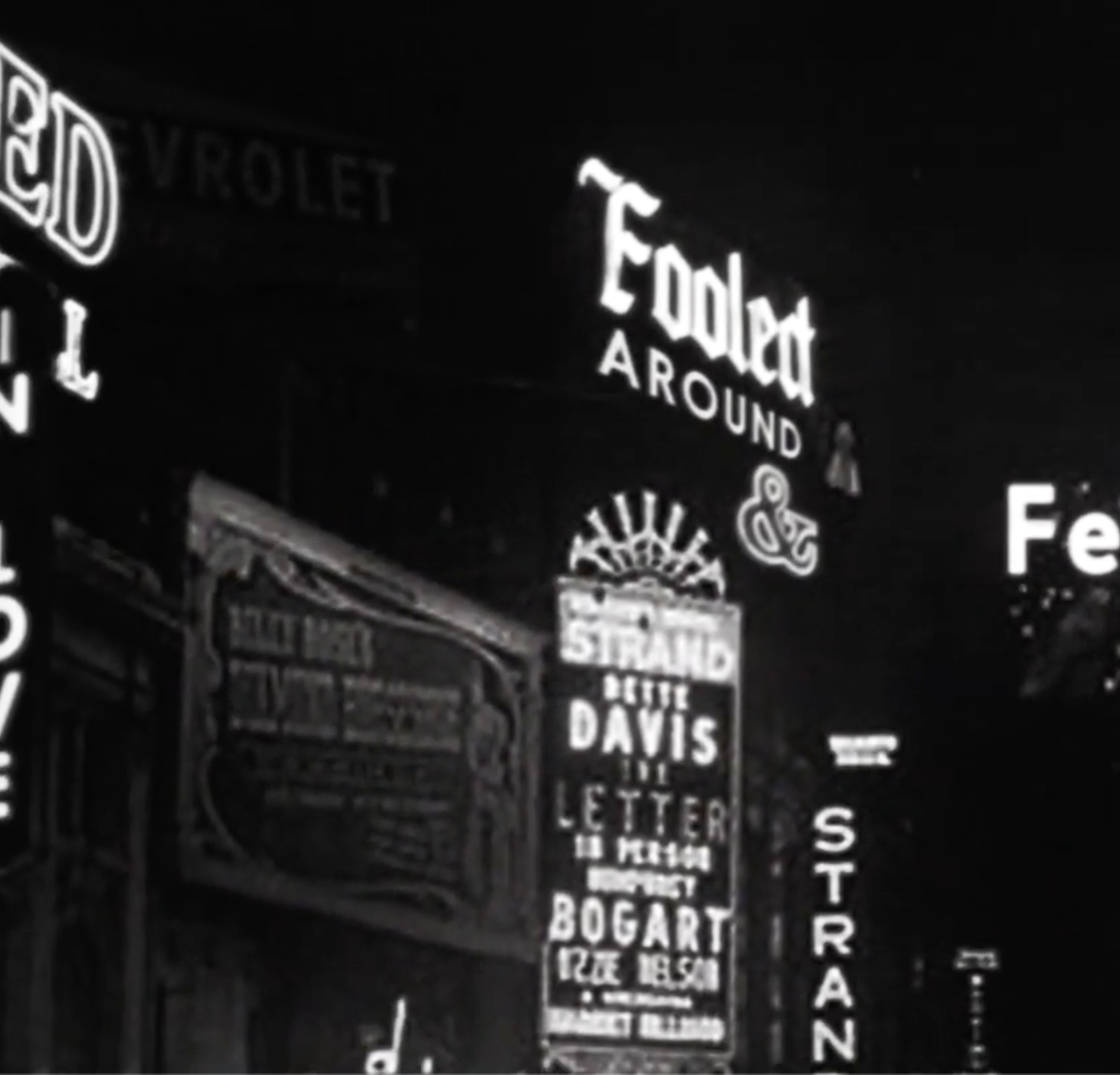
The Letter (1940) opening scene / title sequence
The Letter (1940): Original Trailer - Bette Davis - Herbert Marshall - Film Noir - Classic Dramas
Gangster's Boy (1938)
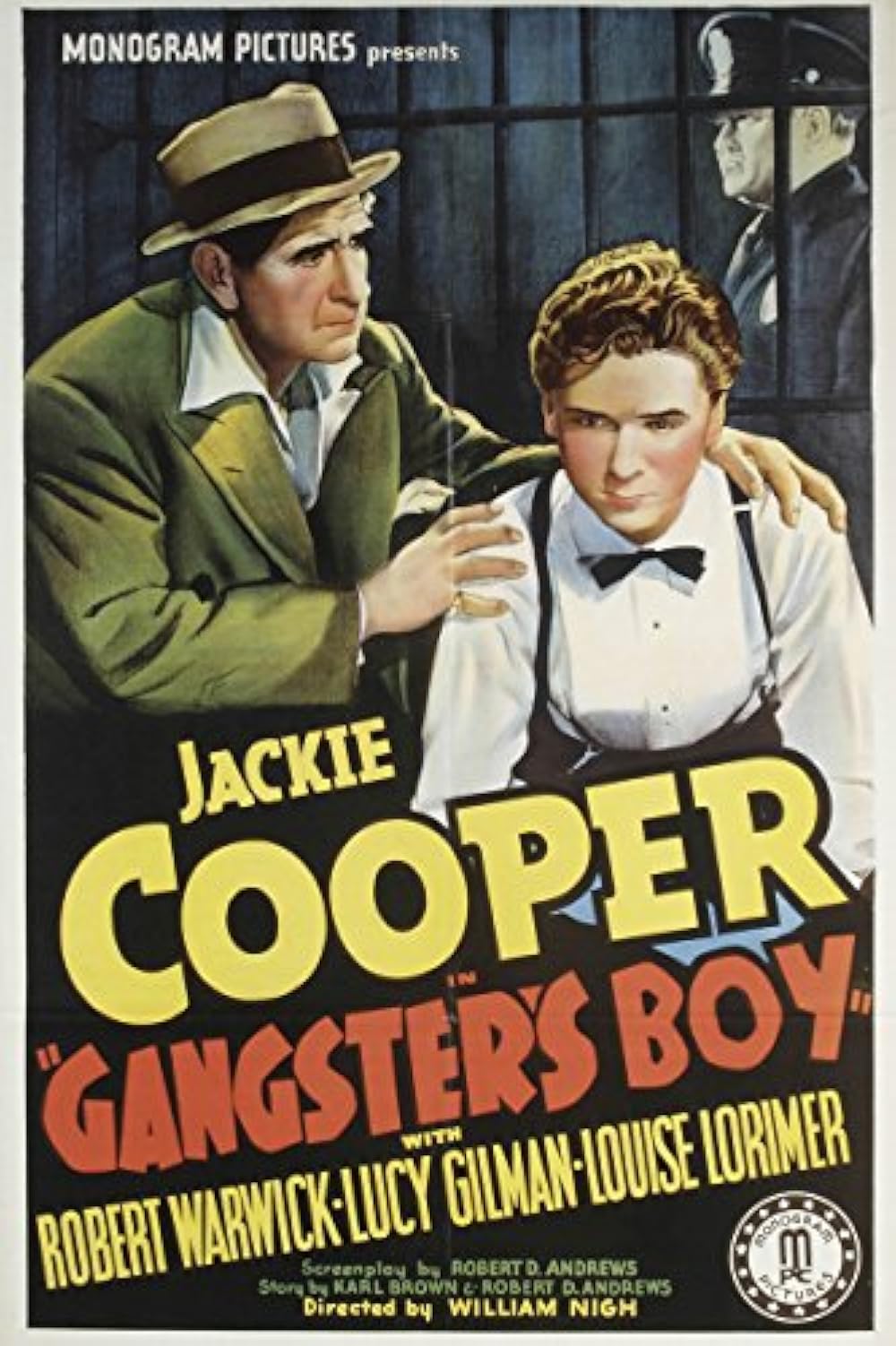
Here Comes the Navy is a 1934 American romantic comedy film directed by Lloyd Bacon. The film stars James Cagney, Pat O'Brien, Gloria Stuart and Frank McHugh.
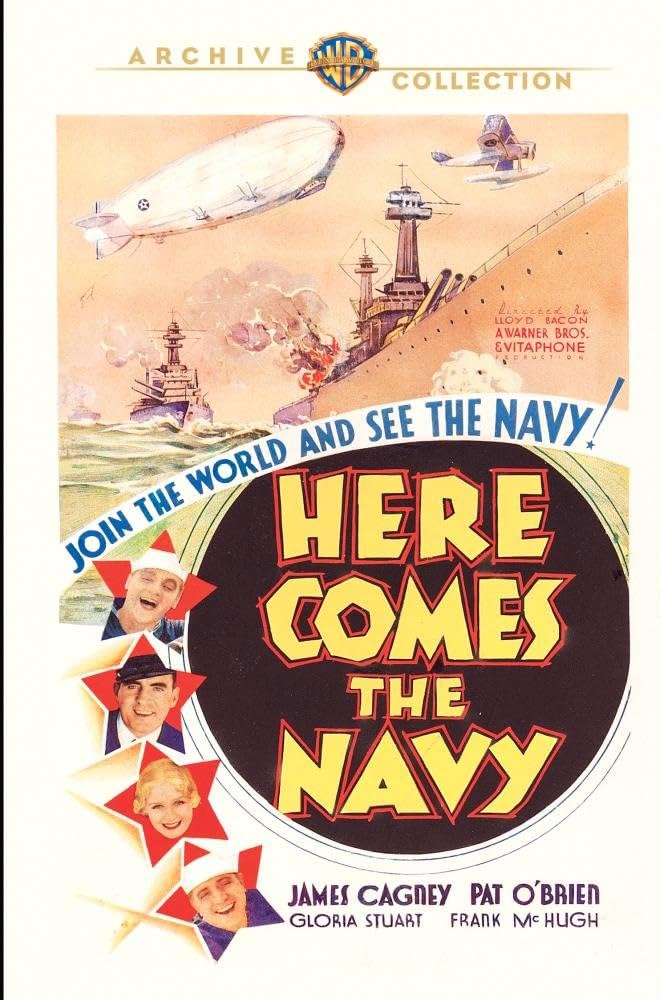

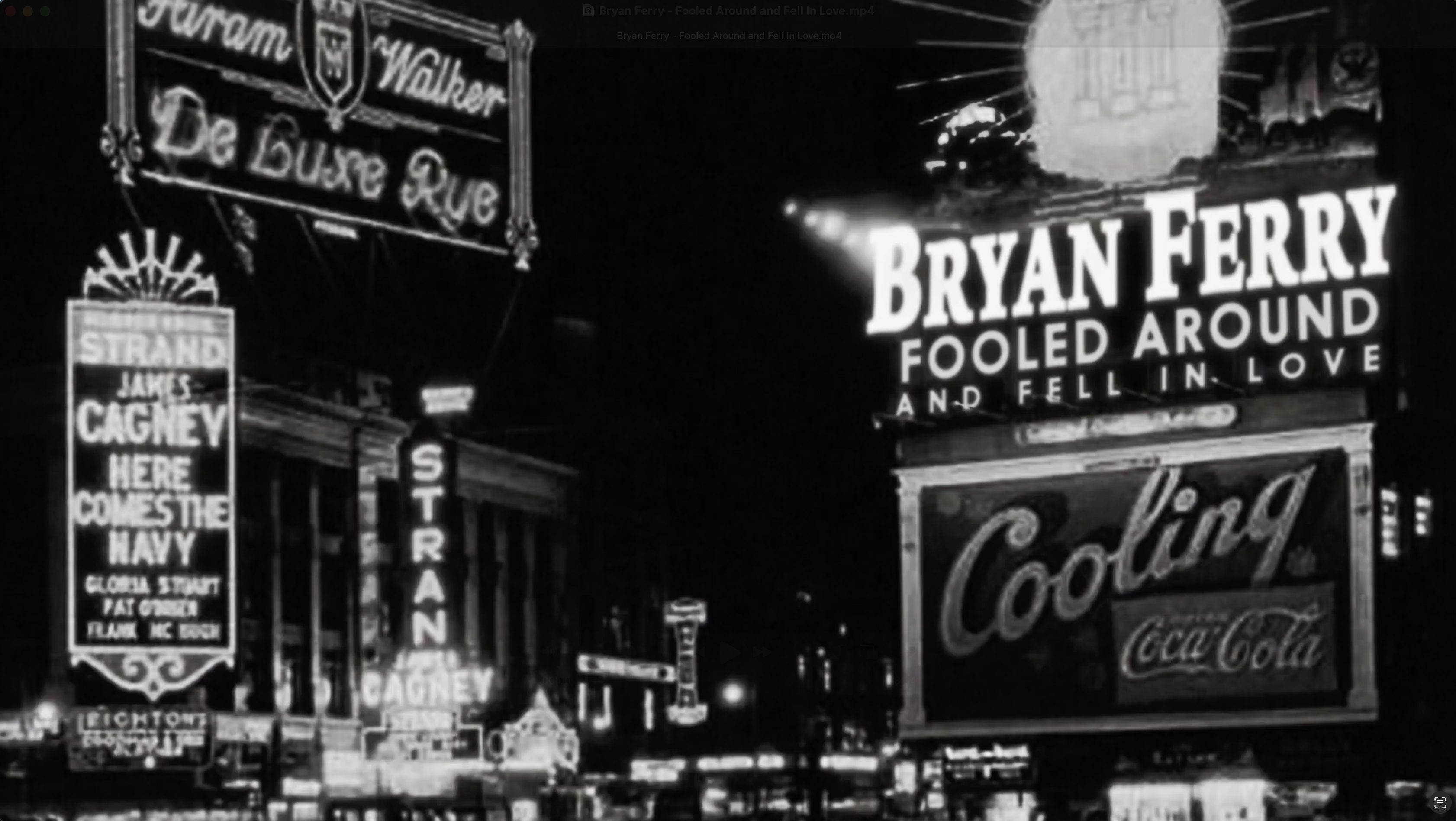
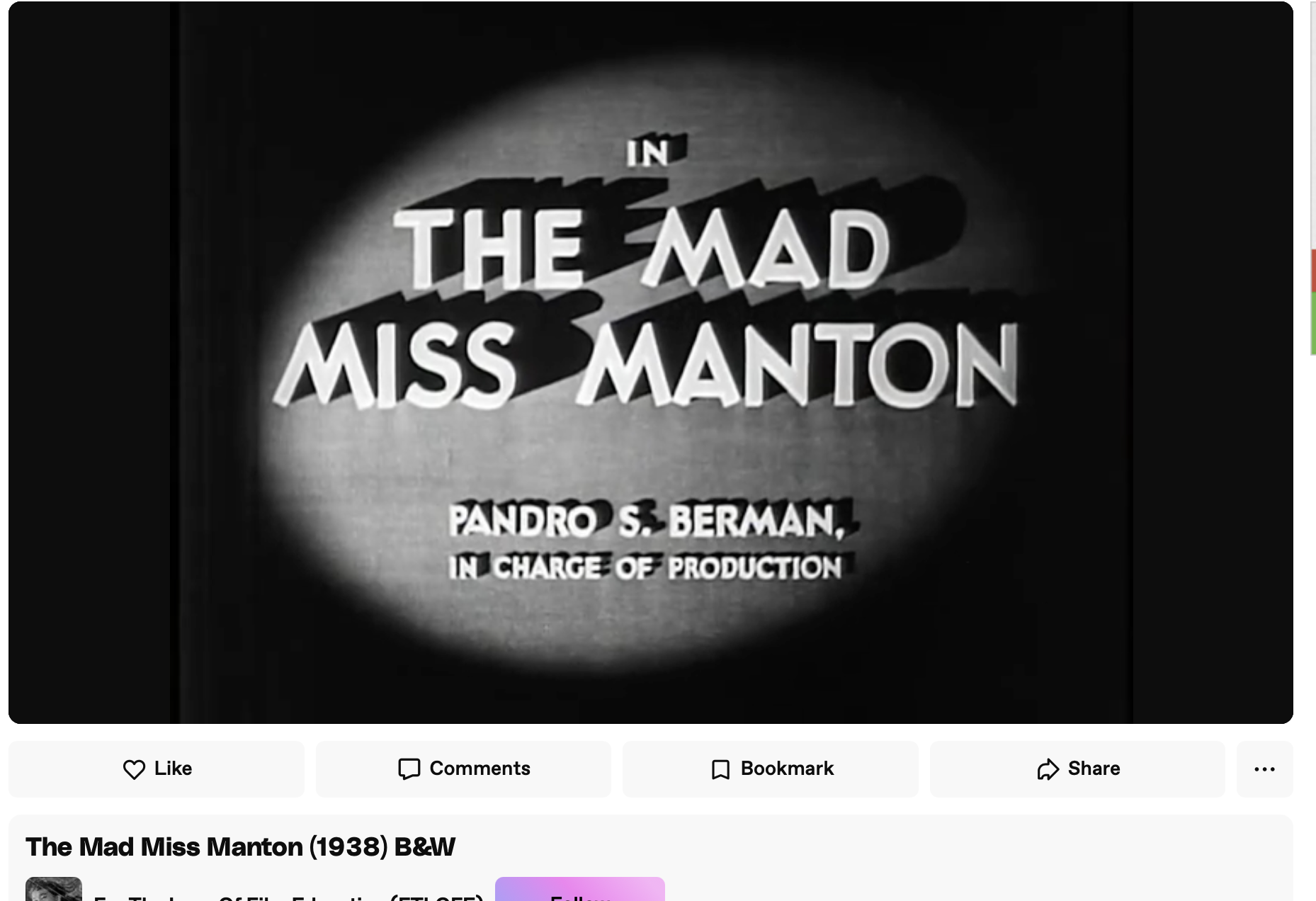
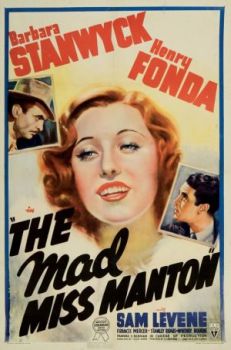
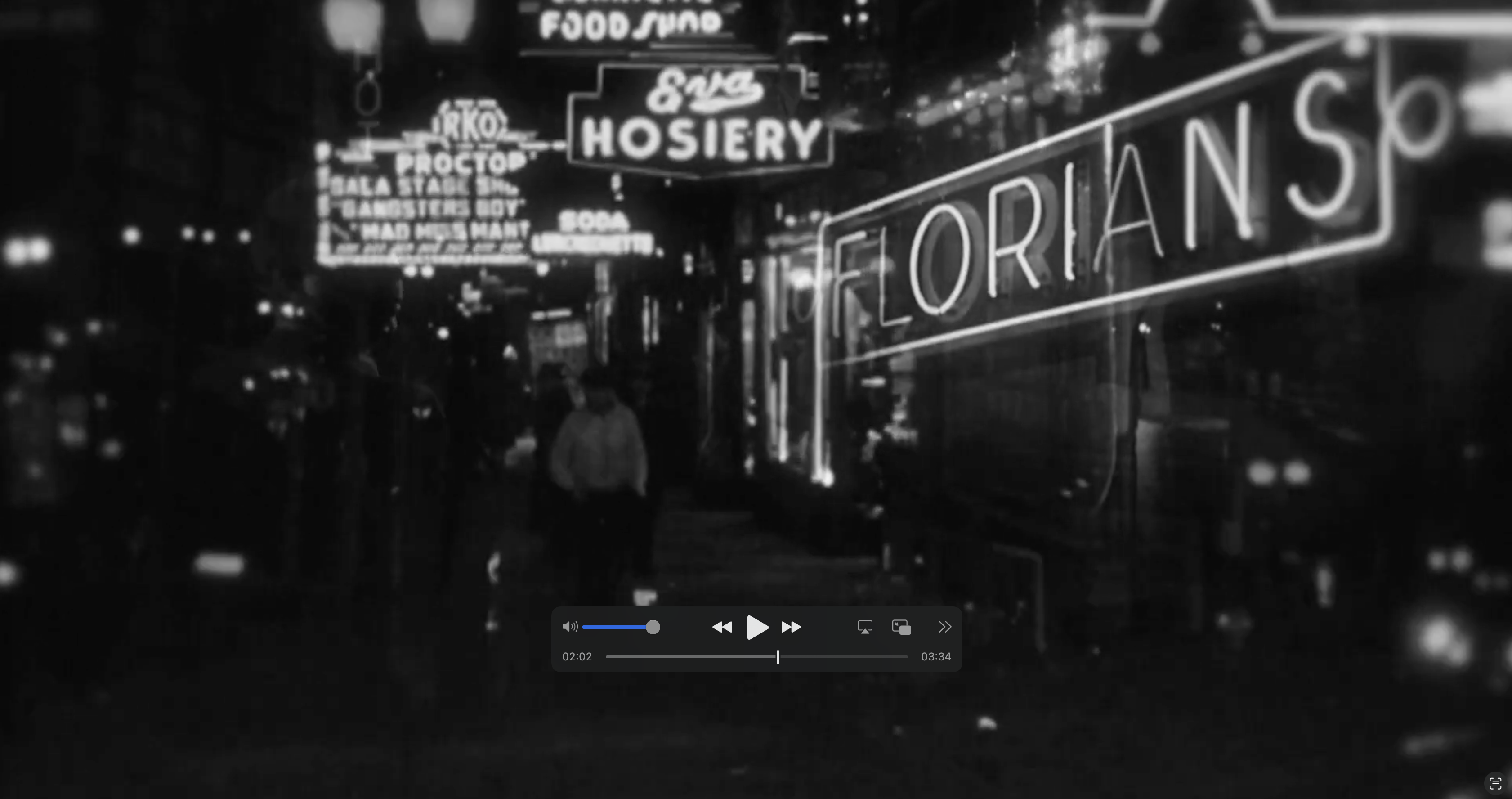
A Dispatch from Reuters (1940) Trailer
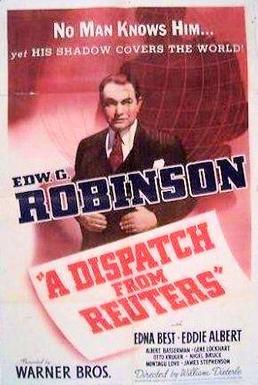
The first time we see the paster for A Dispatch from Reuters, we can not make out the title.
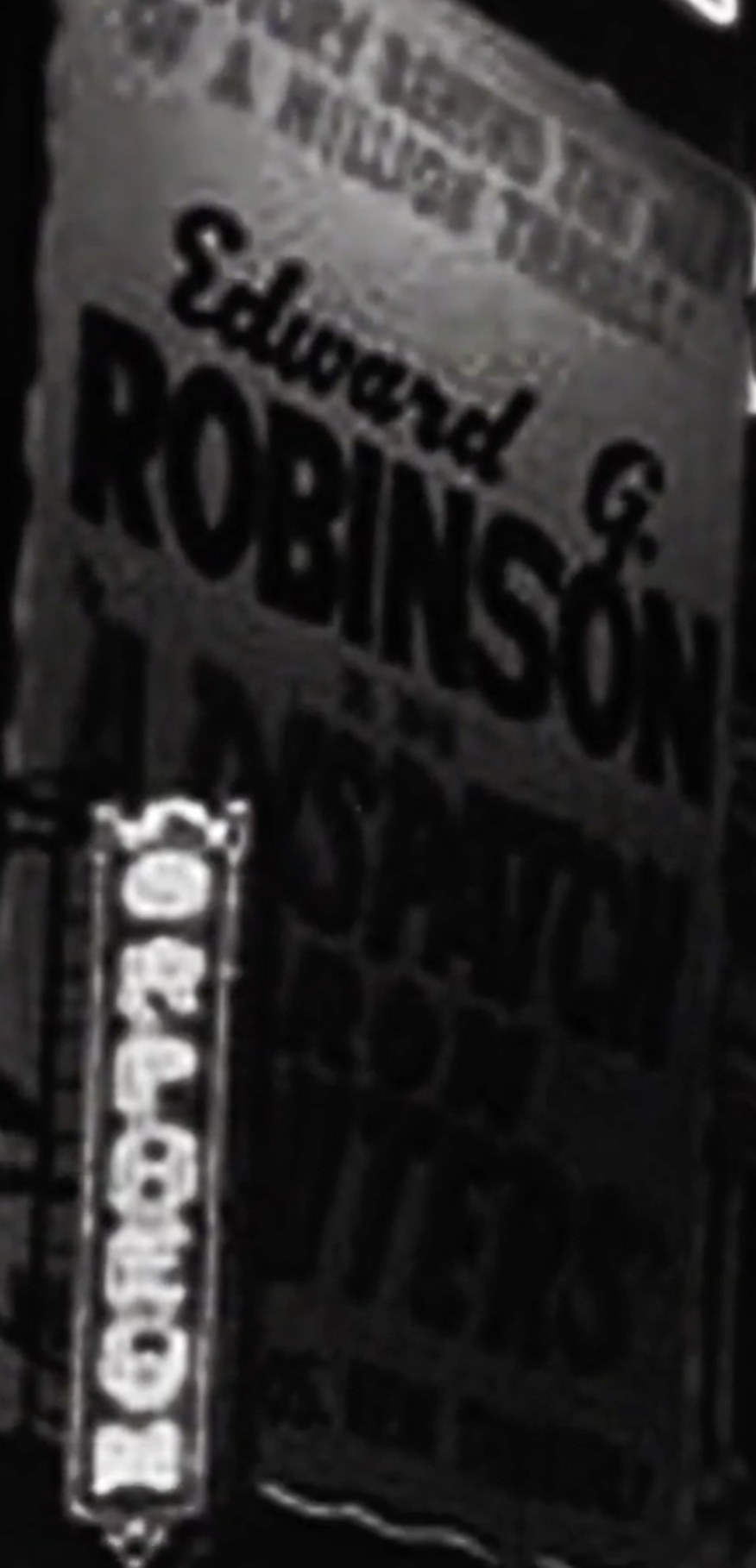
The second time we see the marquee, we can read the title and star's name at the bottom left.
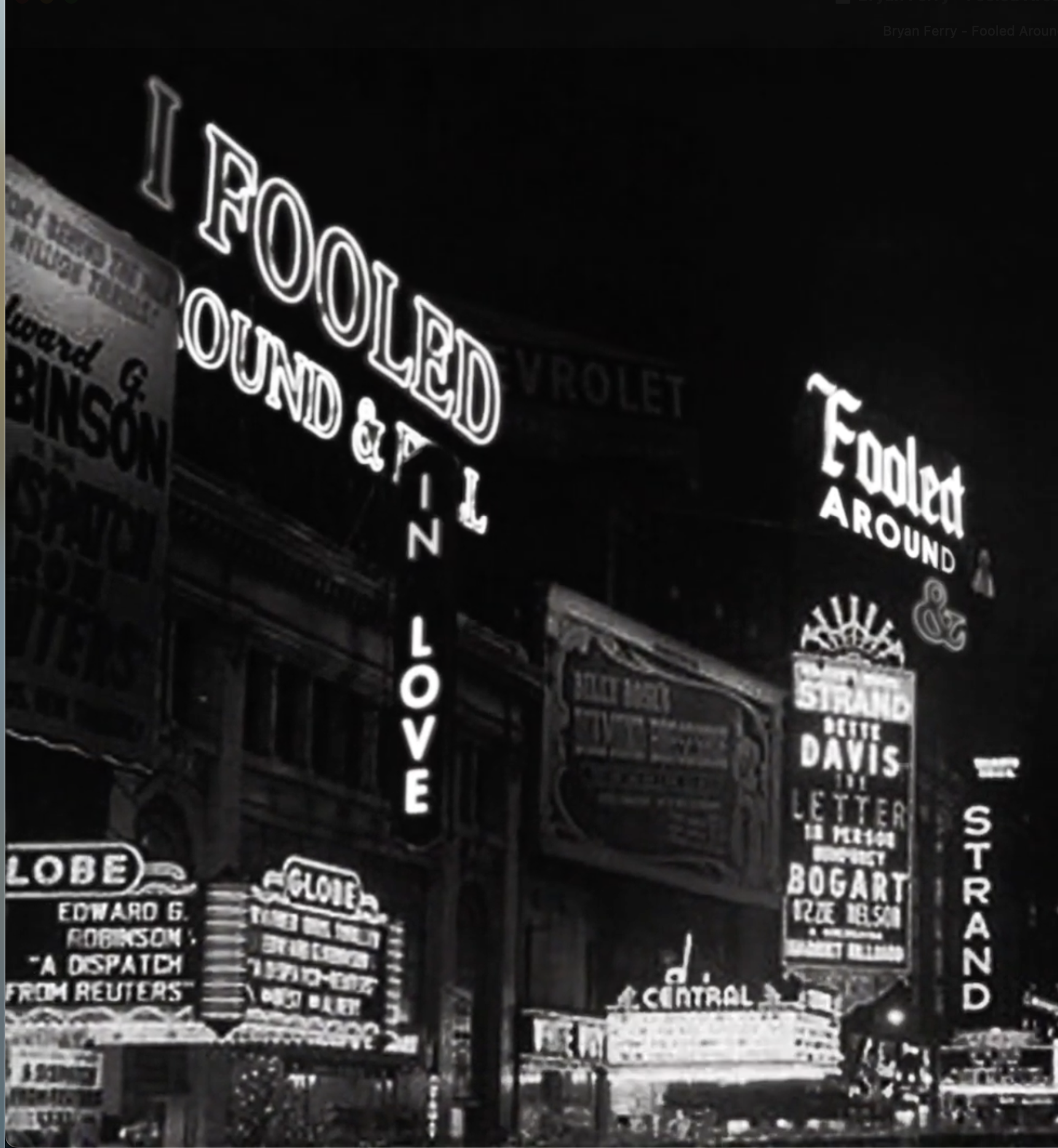
The Killers (1946) | Original Trailer [HD] | Coolidge Corner Theatre
The editing through dissolves as very speeding and mobile camera struggles to keep up with the bouncing balls of lyrics fragment. The lyrics are often in different signs, sometimes neon, as if the lyrics to the song were themselves urban signage. There is more be to read both in the lyrics and the urban signage. Footage from four film noirs dissolve in and out in each quandrant of the frame, make it difficult to know what is happening in them or how they relate to the song. One has to know the noirs pretty well in order to identify the shots the video takes from them.
In Ferry's music video, the California hotel sign on the left is taken from Murder, My Sweet, The shot from the left in Philip Marlowe's (Dick Powell) office. Jeff Bailey is kissing his girlfriend Virginia Huston for the last time as they secretly meet in a forest. Rapid dissolves into two shots on the left the right, one right after the other. On the upper left: That's Mitchum about to discover that he can't open the door because the corpse of the chump he came to warn has been murdered. The one on the left before the one of the right Jeff entering the foyer and then below him lower right, first Jane Greed walks out of the masin building. Jeff is out of the frame as his girlfriend looks on stunned. She fades out as Jeff on left dissolves and he enters the Mason building on the right.
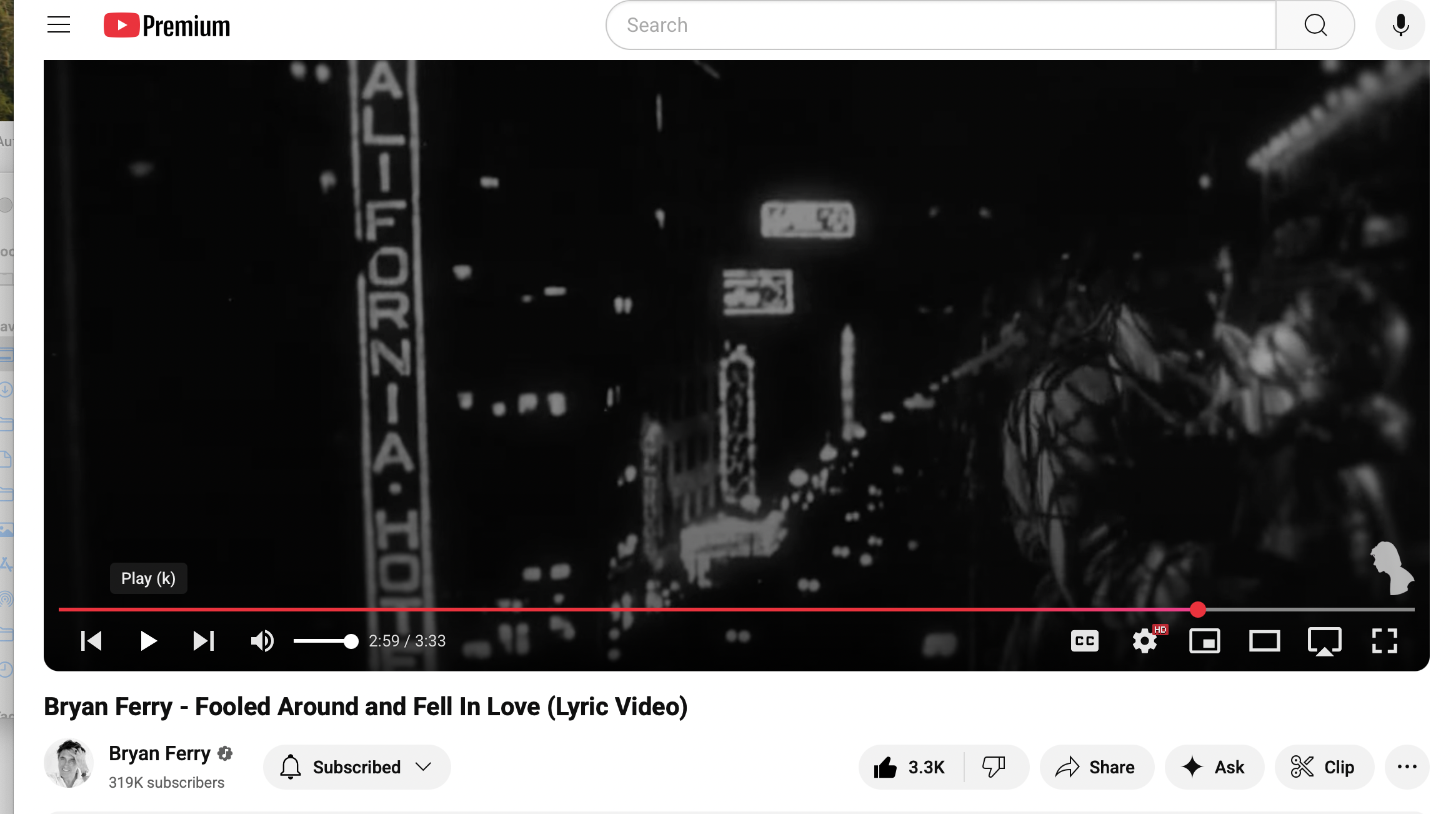
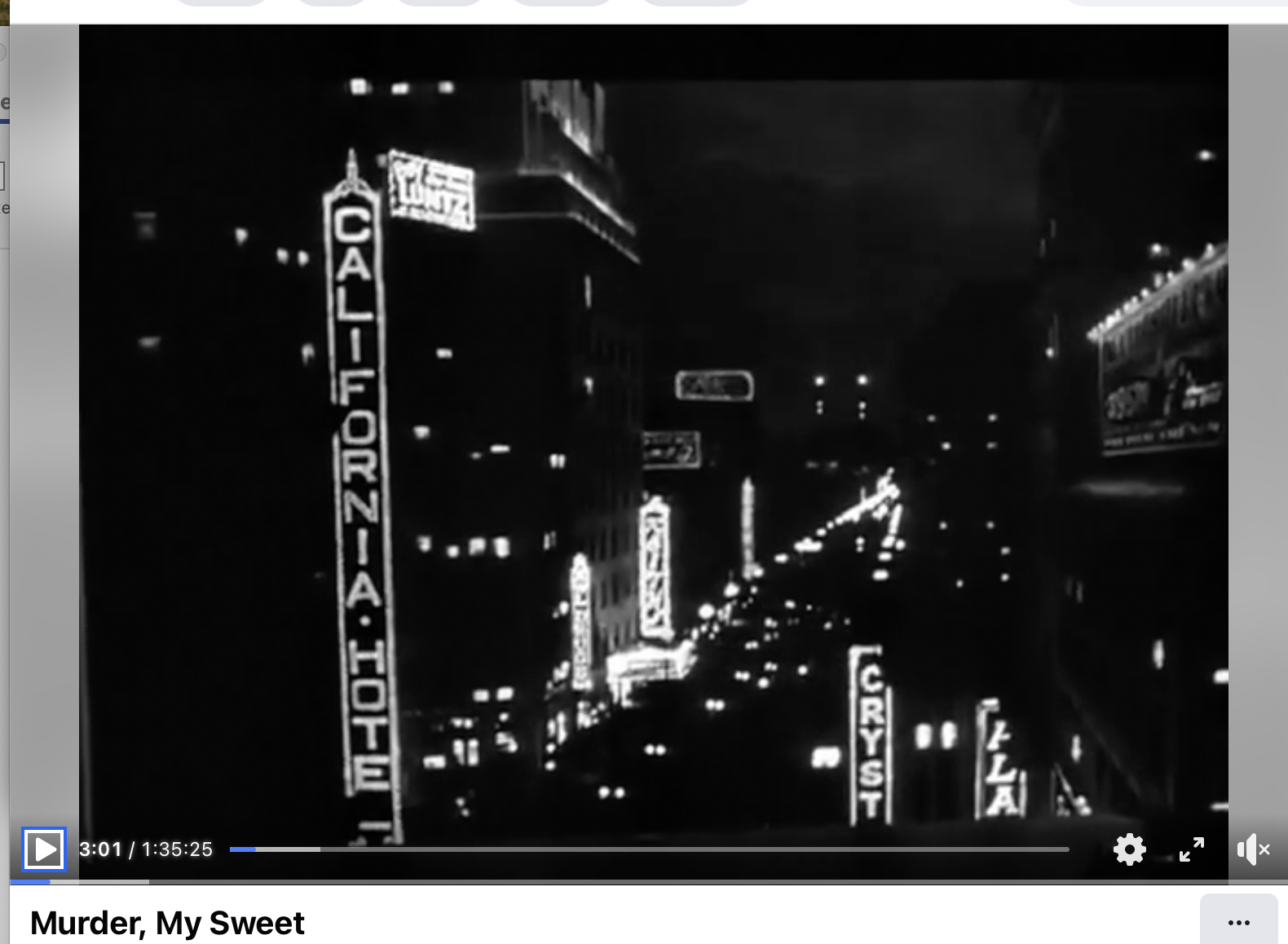
Processed shot though Marlowe's office window.
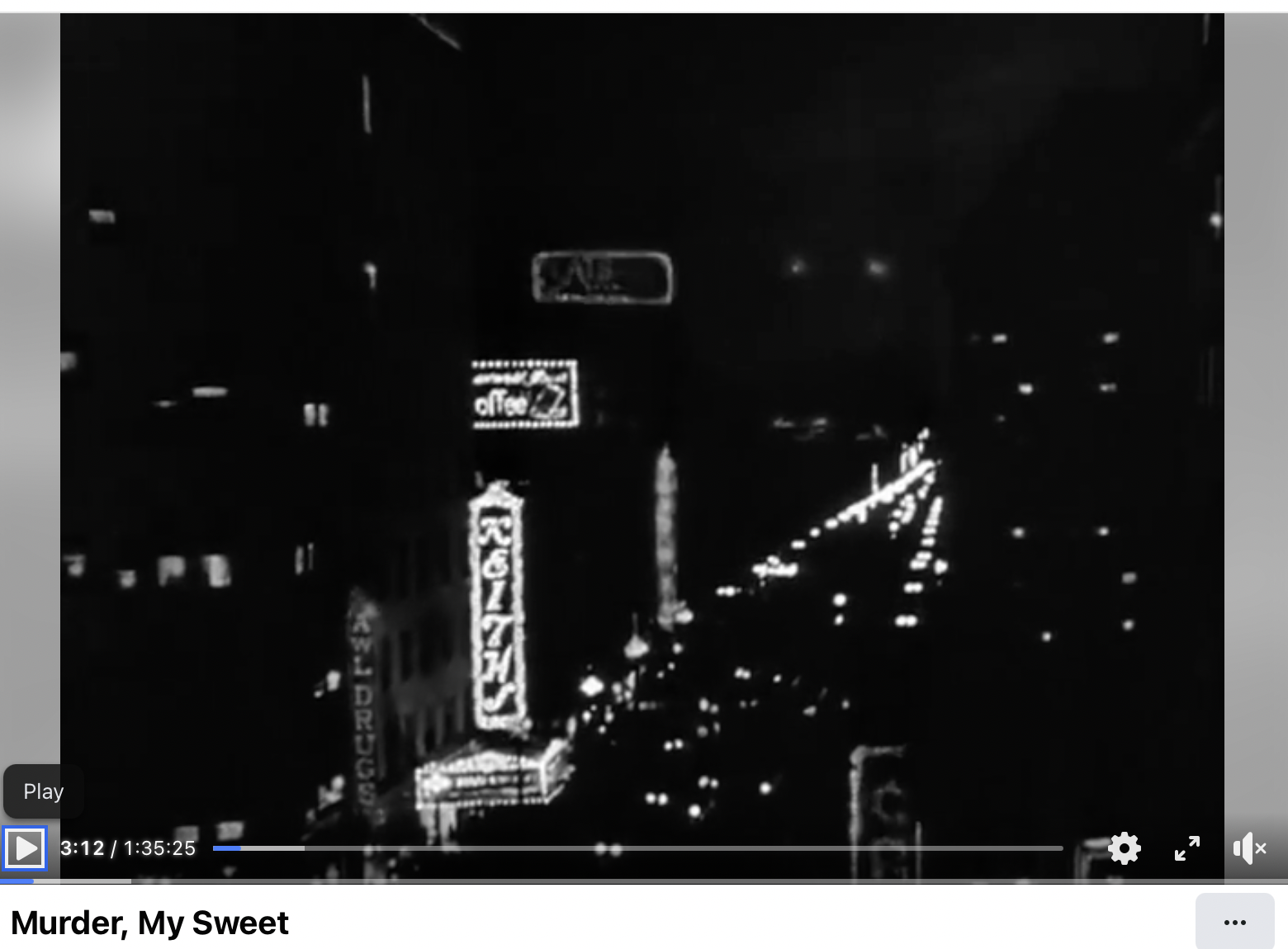 T
TThe second location shot

Eva's Hosiery
In the music video, this location shot dissolves into a neon sign Florians and another of a car driving past.


The car driving past is from another shot in Murder, My Sweet.






Cathy leaving the Mason Building


on the left is of insurance investigator waiting for Kitty and lights a cigarette.


Cut to Dick Powell and Mouse then dissolve back ot the second location shot of Murder my dupeimpoed with Florians. then car drives by from murder. dissolve to third location of Murder, My Sweet
Bryan Ferry, "Fooled Around and Fell In Love"
Ferry brings out a dark side to the original tune by Elvin Bishop (1975). The background with the Hotel California neon sign is taken from the early film noir Murder, My Sweet (dir. Edward Dmytryk, 1944). So is the shot of the Florian’s Neon sign. And so is the shot of man (Dick Powell) starring as Raymond Chandler’s detective (Philp Marloe) standing by a bay window. Clips from famous and early films noir Out of the Past (dir. Jacques Tourneur, 1947), Crossfire (dir. Edward Dmytryk, 1947) and The Killers (dir. Robert Siodmak, 1946) in the middle and the end of the video suggest that Ferry’s character may have fallen in love with a very dangerous dame. My take? Love is like a revolving door. You’re always alone, on the other side of the glass, going in or going out, perhaps caught in the crossfire. The stars from the films are Robert Mitchum as reformed gas station owner, Jane Greer as a femme fatale, Ann Shirley as her rival; Dick Powell in a break out role as a hardboiled private detective; the hard but soft Gloria Grahame dancing alone with the falsely accused on the run private George Cooper; Claire Trevor, Ava Gardner (the incarnation of the femme fatale), and Edmund O’Brien as a brilliant insurance investigator. Virginia Huston, Burt Lancaster, and Edna Best do not appear in the video.
Bette Davis in the melodrama The Letter (dir. William Wyler, 1940), a remake of an earlier film using the same title, and Edward G. Robinson in A Dispatch from Reuters (dir. William Dieterle, 1940) are on theater marquees.
01:00 The Strand theater marquee in the lower left of the first shot is showing Here Comes the Navy (dir. Lloyd Bacon, 1934), a comedy starring James Cagney, Gloria Stuart, Pat O'Brien, and Frank McHugh.
1:46 The sign “California Ho[tel]” on the left is from a processed shot in Murder, My Sweet.
1: 46-53; recurs at 3:05. Jeff Bailey (Robert Mitchum) is wearing a trench coat coming through the revolving door in Out of the Past (1947). Spoiler alert. Bad girl car passenger Jane Greer shoots him and he crashes the car with her in it once he sees the cops have set up a roadblock to stop them. They both die. Mitchum is going through the door on the left.
1:55 That is Greer walking out of a revolving from the Mason door onto the sidewalk in the lower left building Mitchum just entered at on the upper right. You can make out the word California cut off at the left side of the frame.
https://en.wikipedia.org/wiki/Gangster%27s_Boy
1:58-2:00 Dissolves from Mitchum in the upper right to Dick Powell on the left turned away from the camera. Murder, My Sweet (dir. Edward Mytrk, 1944) Dick Powell is about to see Mouse Molloy, Mike Mazurki's reflection in the window. Mouse Molloy just got out of jail and wants to hire Marlowe to find the woman who dumped him, Velma,
Exactly at 2:00, the reflection (oversized) of Molloy’s face appears in the top center of the frame.
2:02 Another location shot from Murder, My Sweet provides the background. On the RKO movie marquee on the left side of the frame across from the neon sign “Florians” appears as a car is coming from the right (this is also a location shot from Murder, My Sweet) are a 1938 drama Gangster’s Boy and a 1938 screwball comedy about a murder investigation, The Mad Miss Manton, though it looks like the title is Mad Miss Man.
https://en.wikipedia.org/wiki/The_Mad_Miss_Manton
https://en.wikipedia.org/wiki/Gangster%27s_Boy
1:46; 2:59 The lower right corner of the frame shows Mitchum kissing good girl Virginia Hutson goodbye in Out of the Past.
3:04 Mitchum entering a door on the left and entering the Mason Building on the right. That shot matches an earlier shot of him kissing bad girl Greer.
3:13 Working girl Gloria Grahame is dancing with murder suspect on the run soldier George Cooper in Crossfire (1947).
3:18 upper right corner is Kitty Collins, Ava Gardner and in lower right corner are hitmen Charles McGraw and Robert Gannon walking to the diner in the title sequence shot of The Killers (1946). Gannon is on the left and McGraw is on the right. They have come to kill the “Swede” (Burt Lancaster), who knows Gardner has betrayed him. Even though he is alerted that the killers are on their way, Lancaster just lies in bed until they open the door to his room and shoot him dead in the dark.
3:22-3:31 That is insurance investigator Edmund O’Brien on the sidewalk striking a match to light a cigarette near the end of The Killers. The shot of the taxi and the bar named The Green Cat is also from The Killers. That’s Gardner and O'Brien getting out of the taxi.
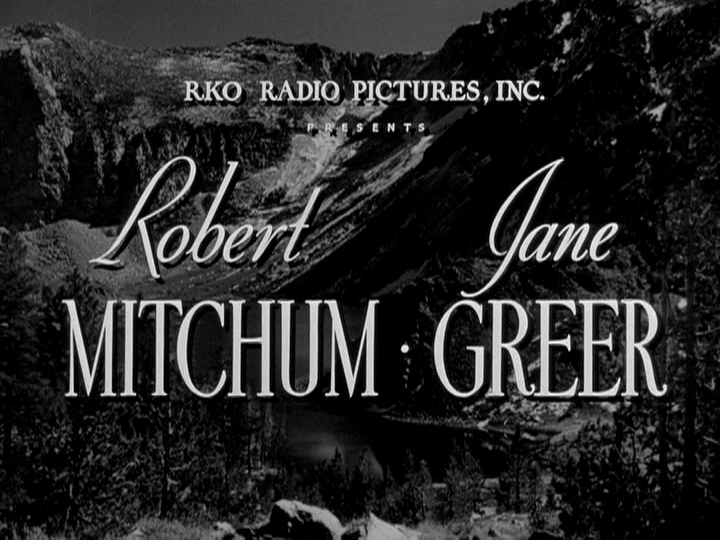
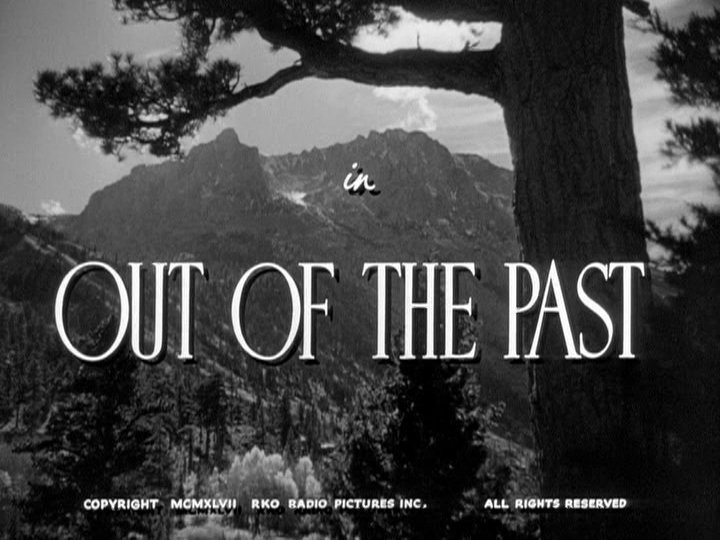
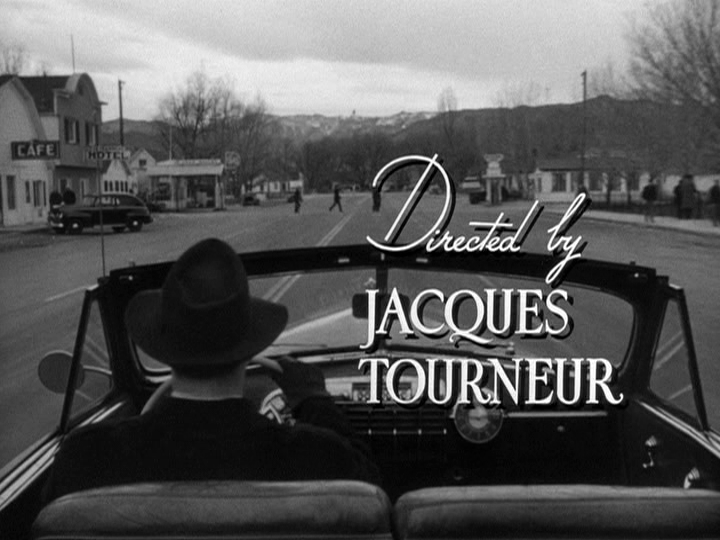
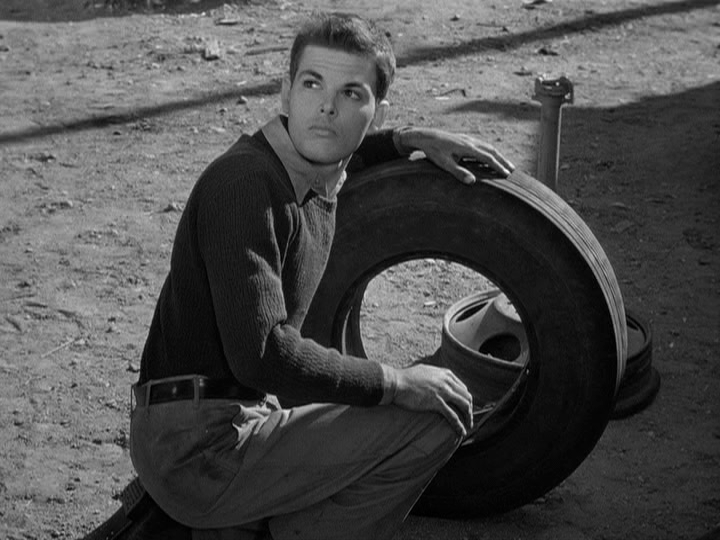
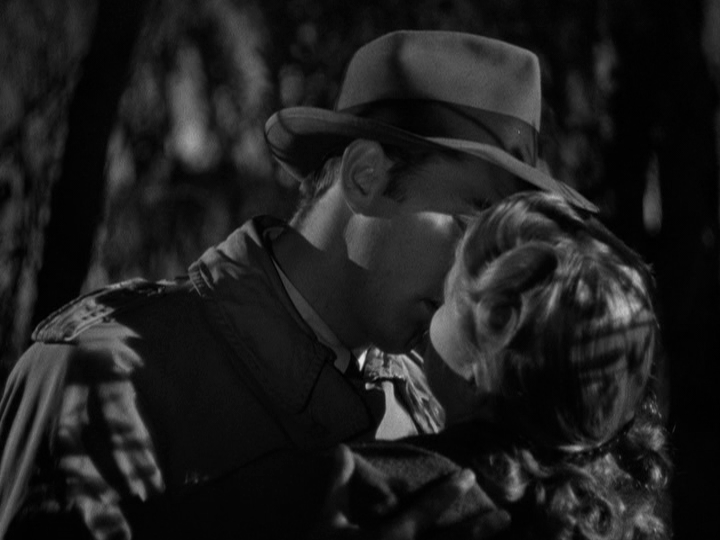

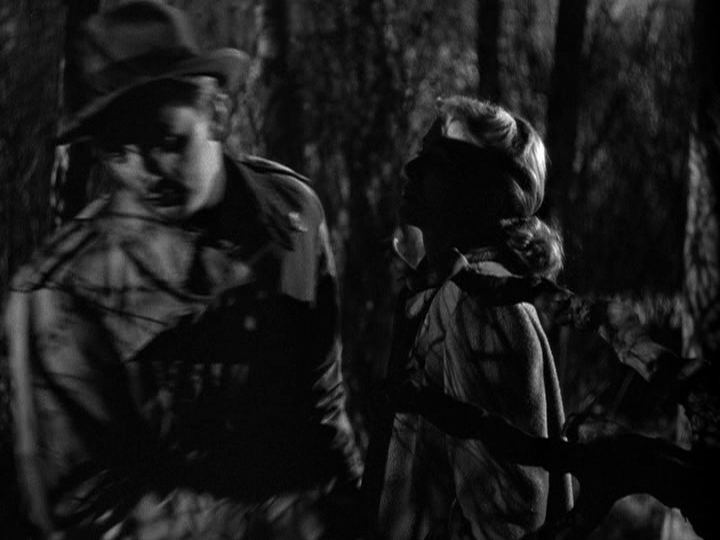
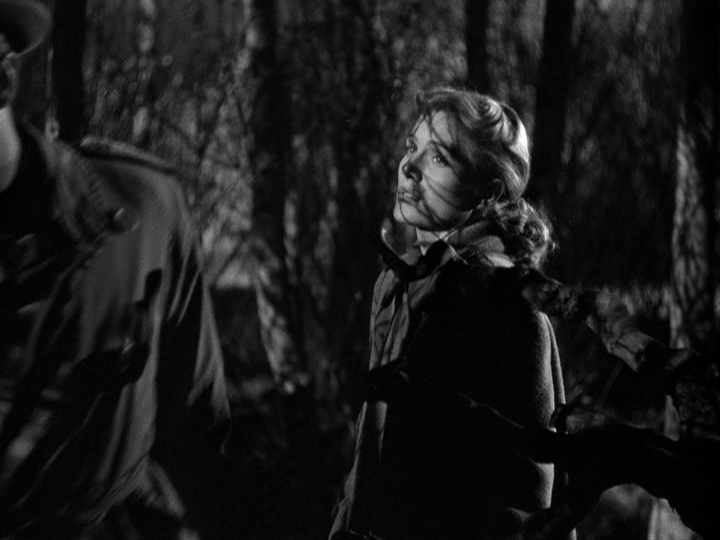
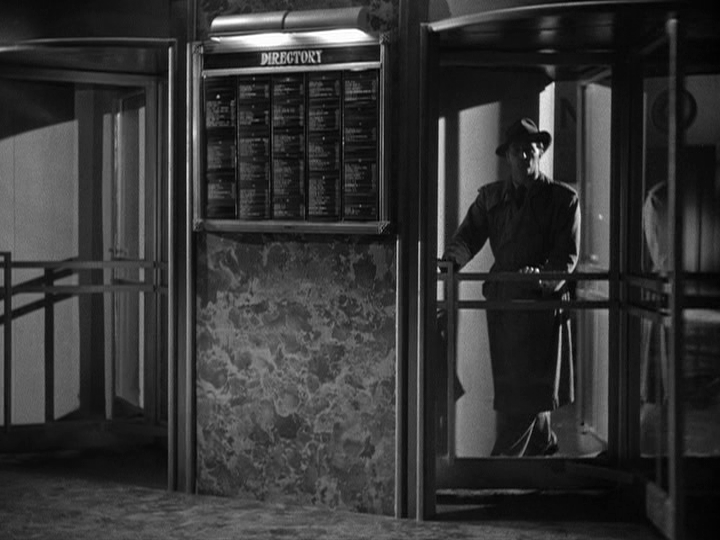
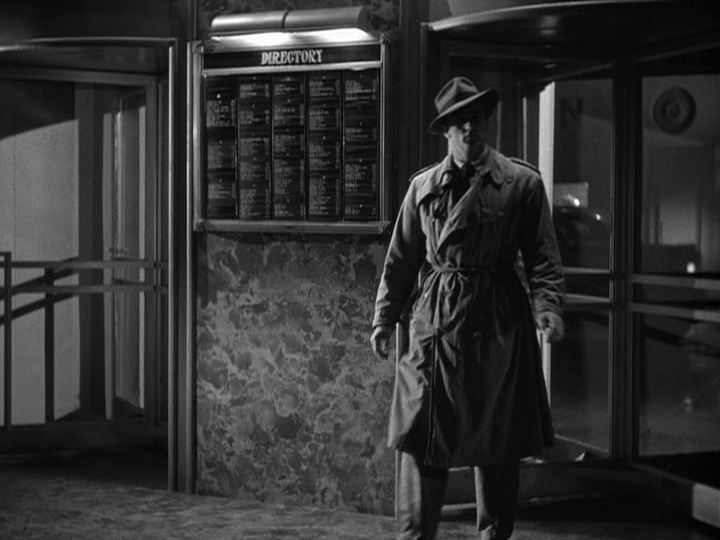
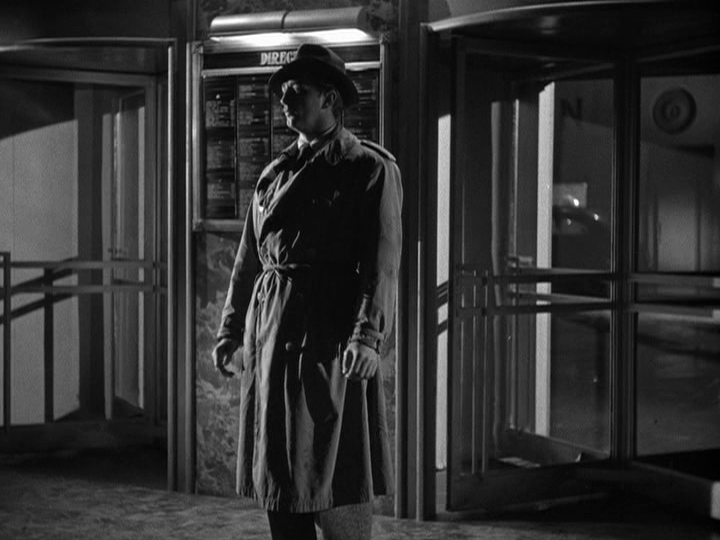
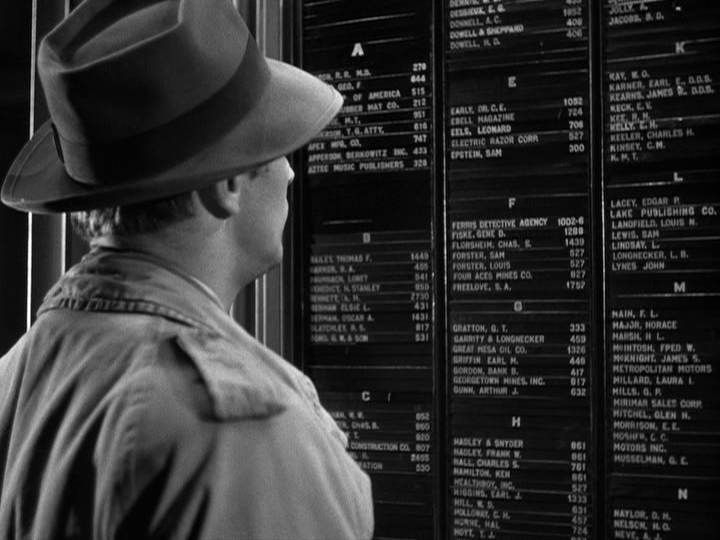
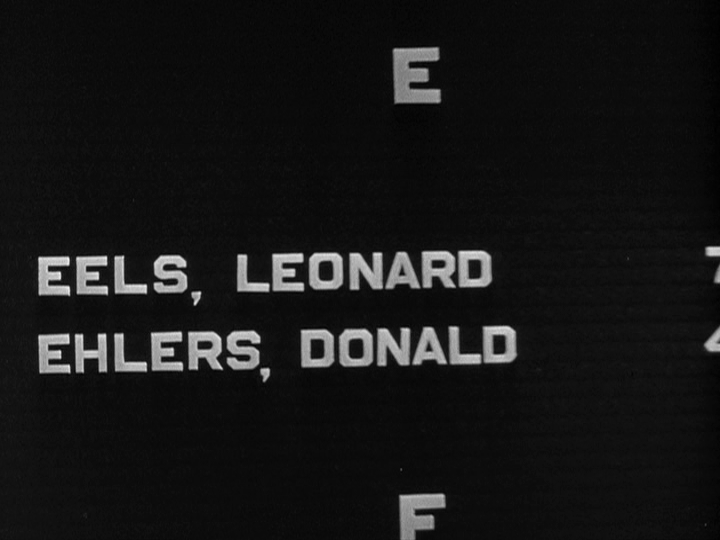
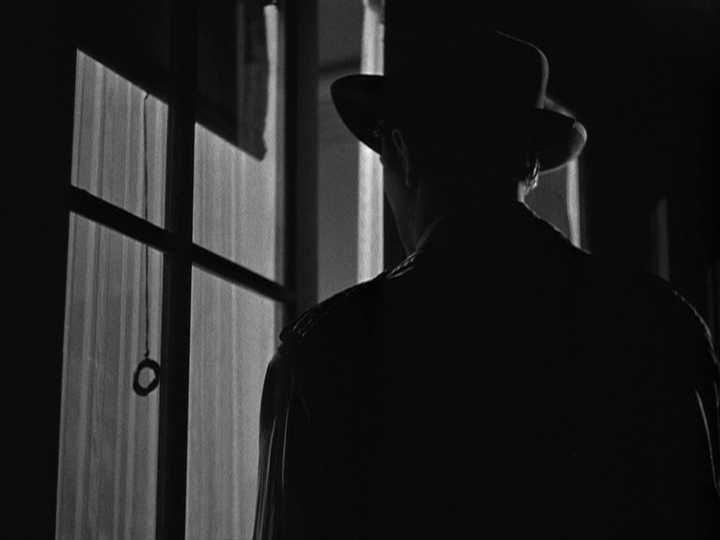
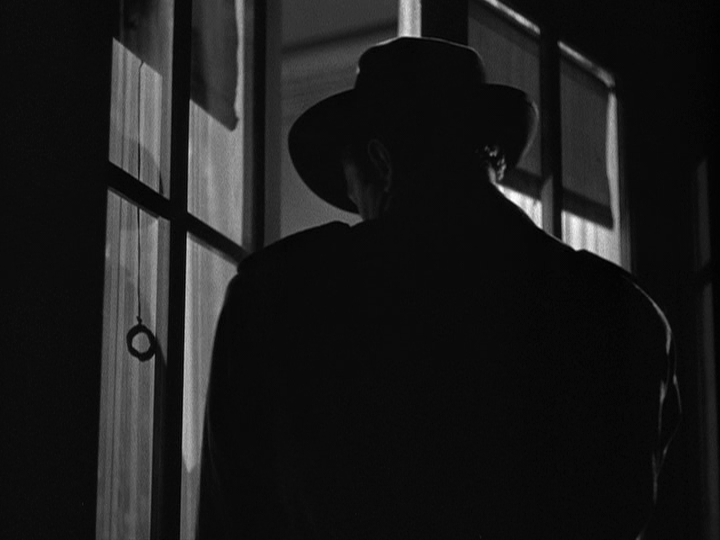
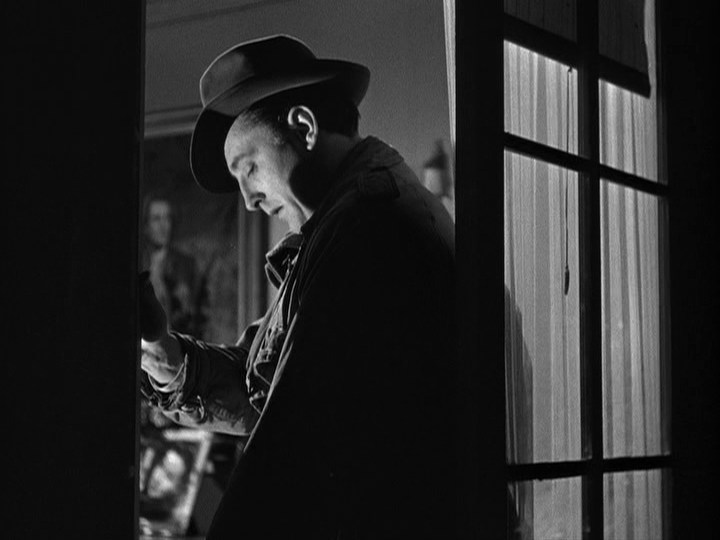
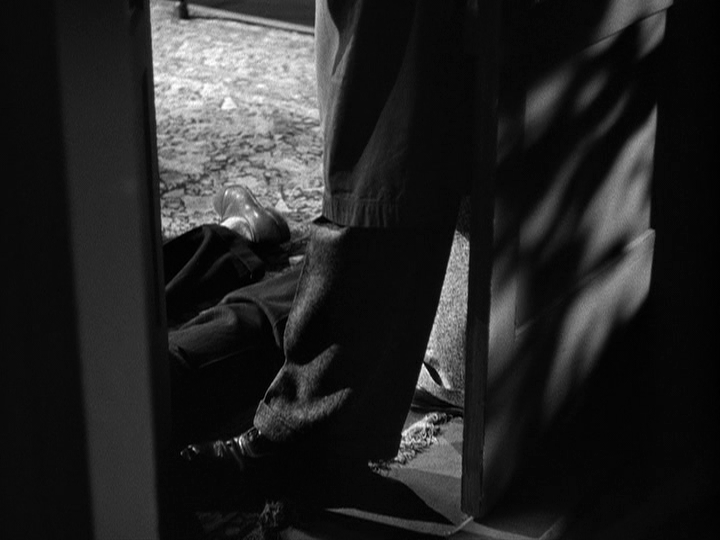
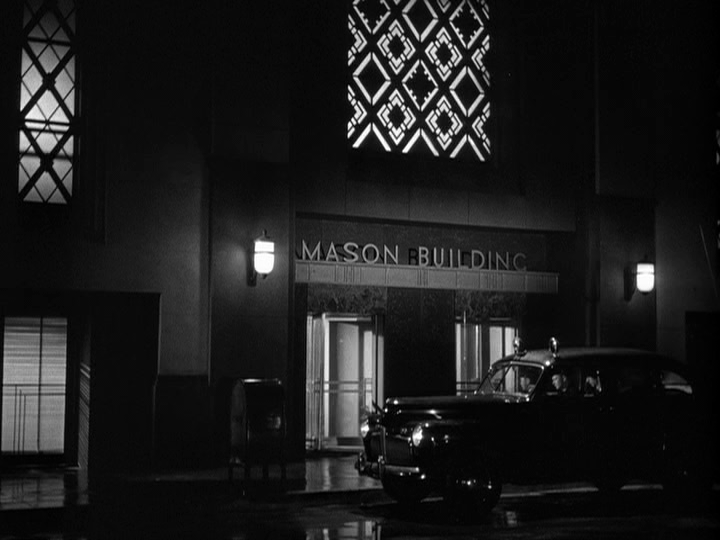
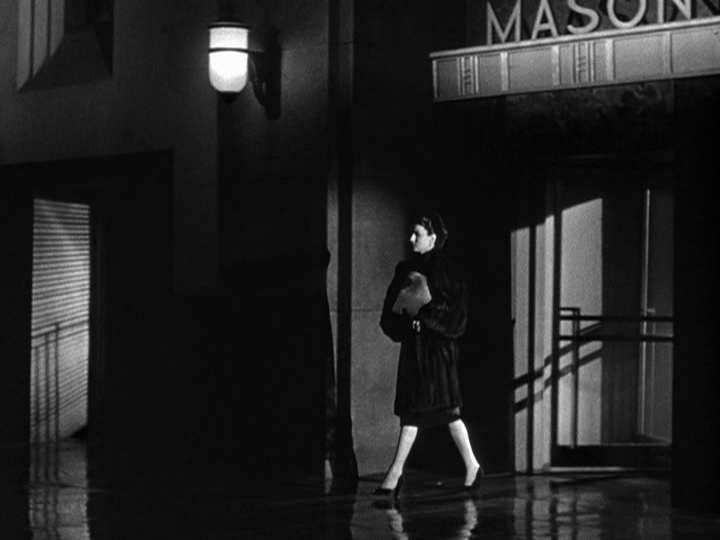
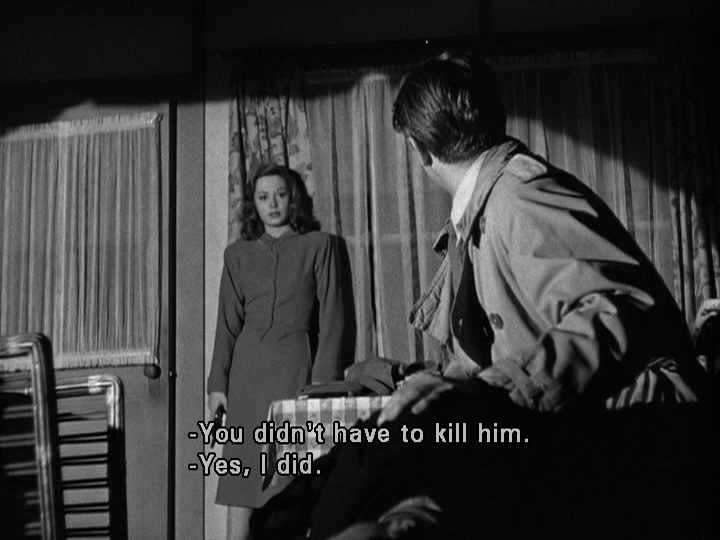
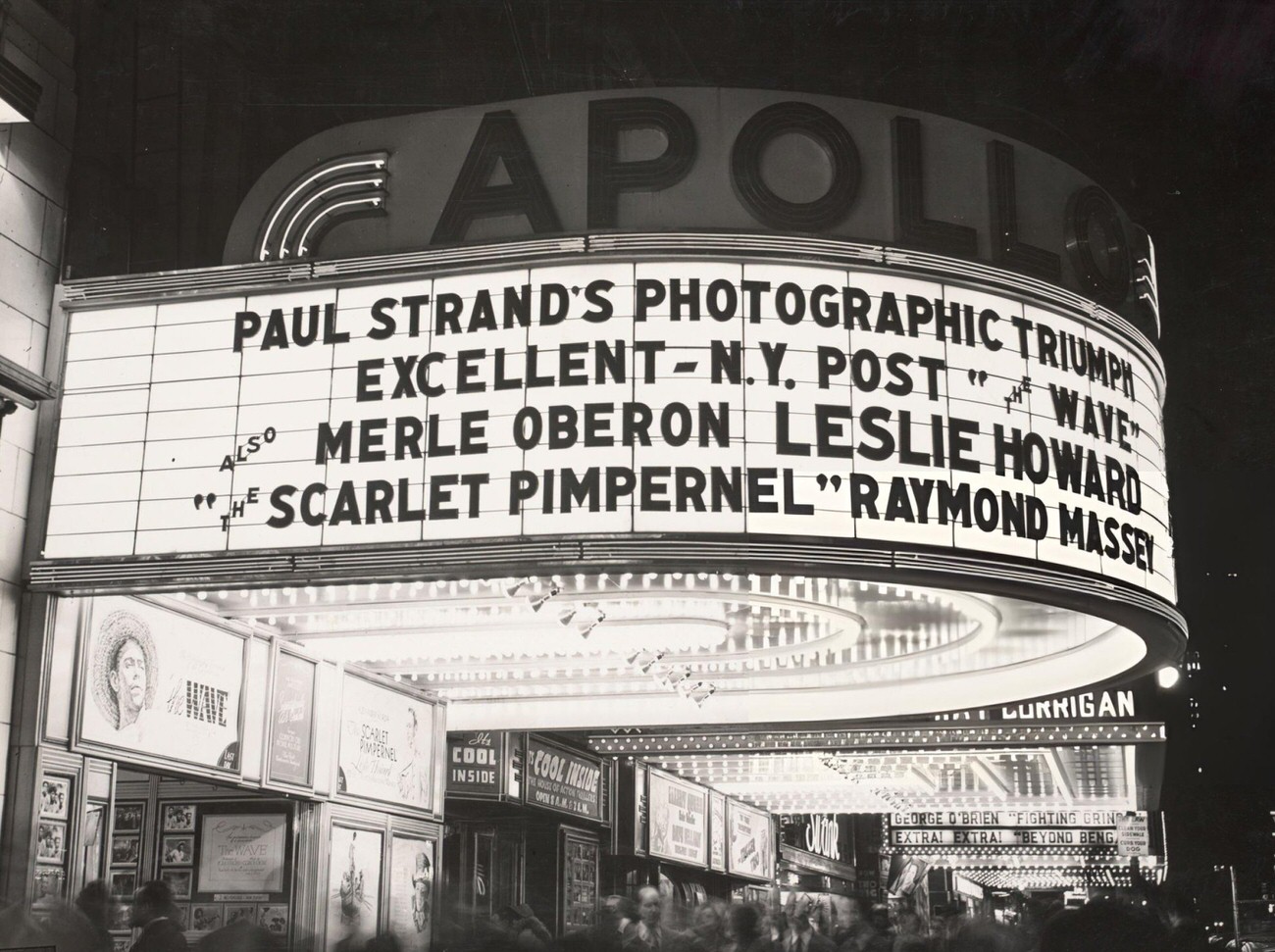
In the "To BE FOUND" department (the same actor in two of the films)
Dickie Moore the deaf must garage attendent credited in Out of the Past.
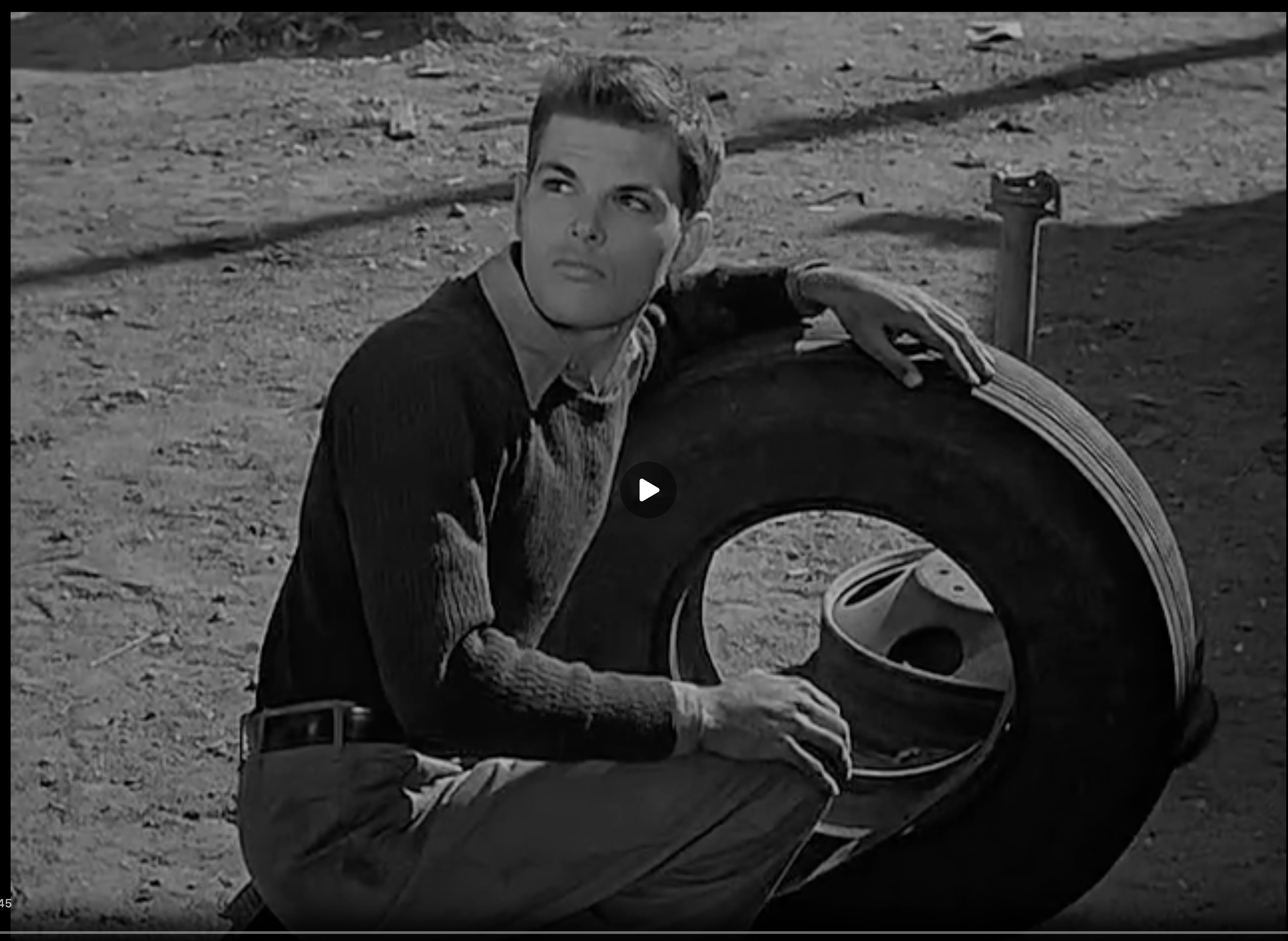
Dickie as the young Reuters (uncredited) in A Dispatch from Reuters
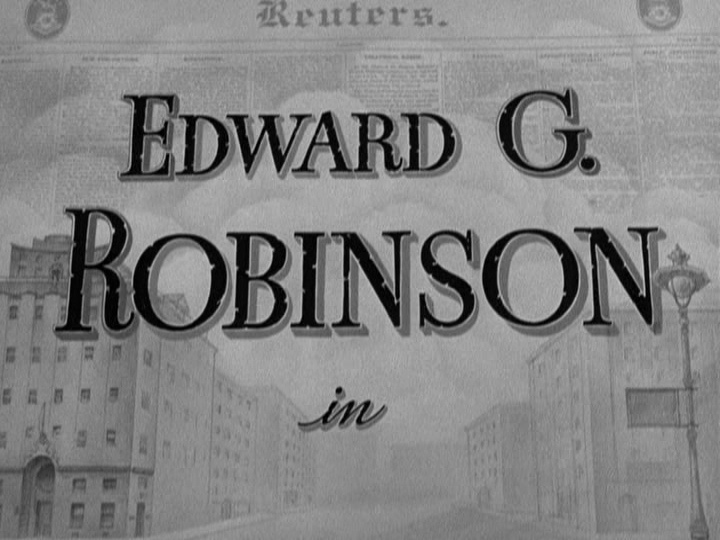
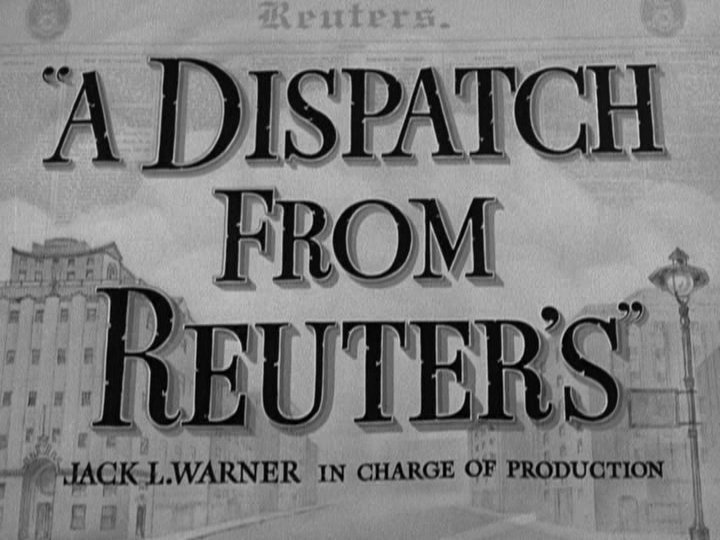
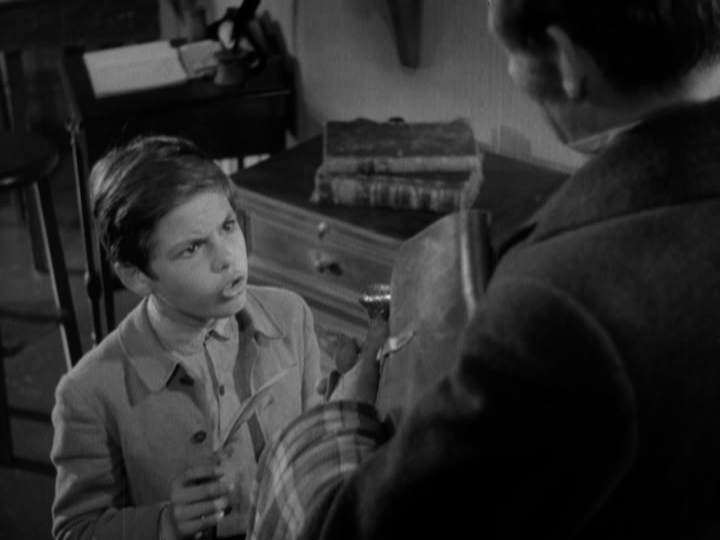
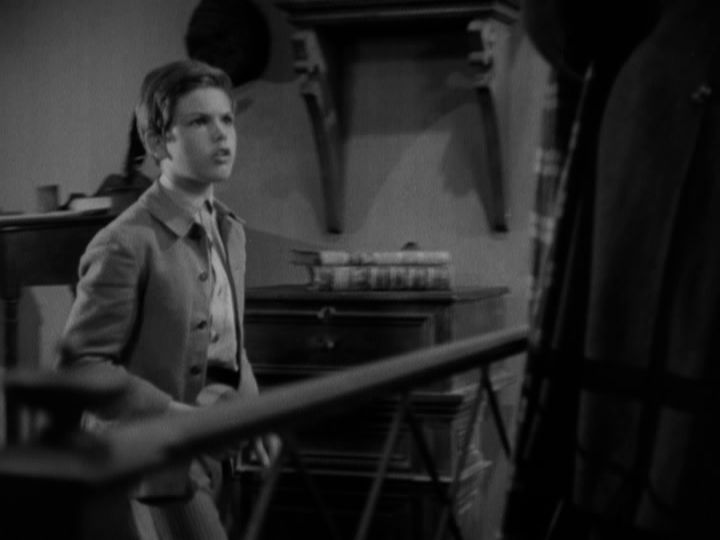
https://twentyfourframes.wordpress.com/2010/04/28/times-square-revisited-astor-theater/
https://www.gettyimages.com/search/2/film?phrase=times+square+1940s
https://www.superstock.com/asset/times-square-night-broadway-th-street-circa-neon-marquees-movie/4186-21777448
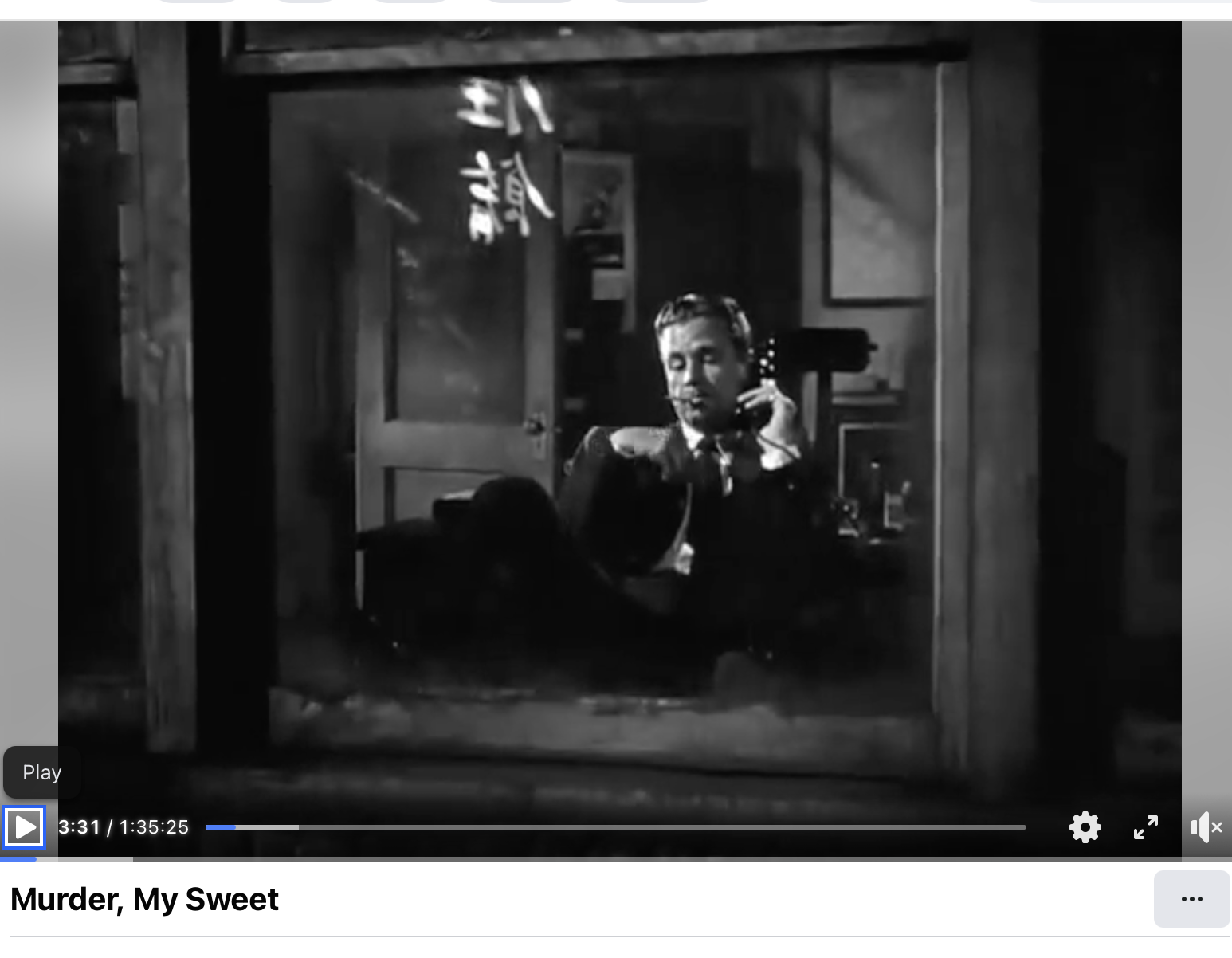
The CHinese ideogrpahs reflected in hte wondow sugest that Marlowe's office is either in Chinatown right next to it.
Dark Past (1948) title sequence
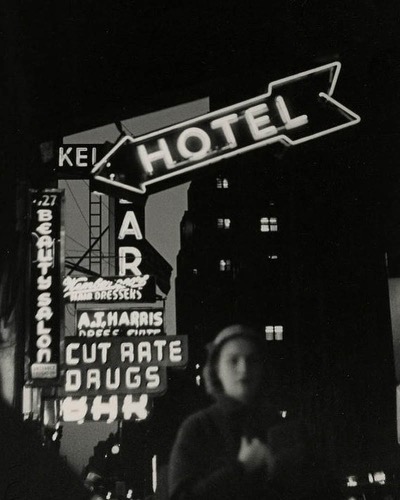

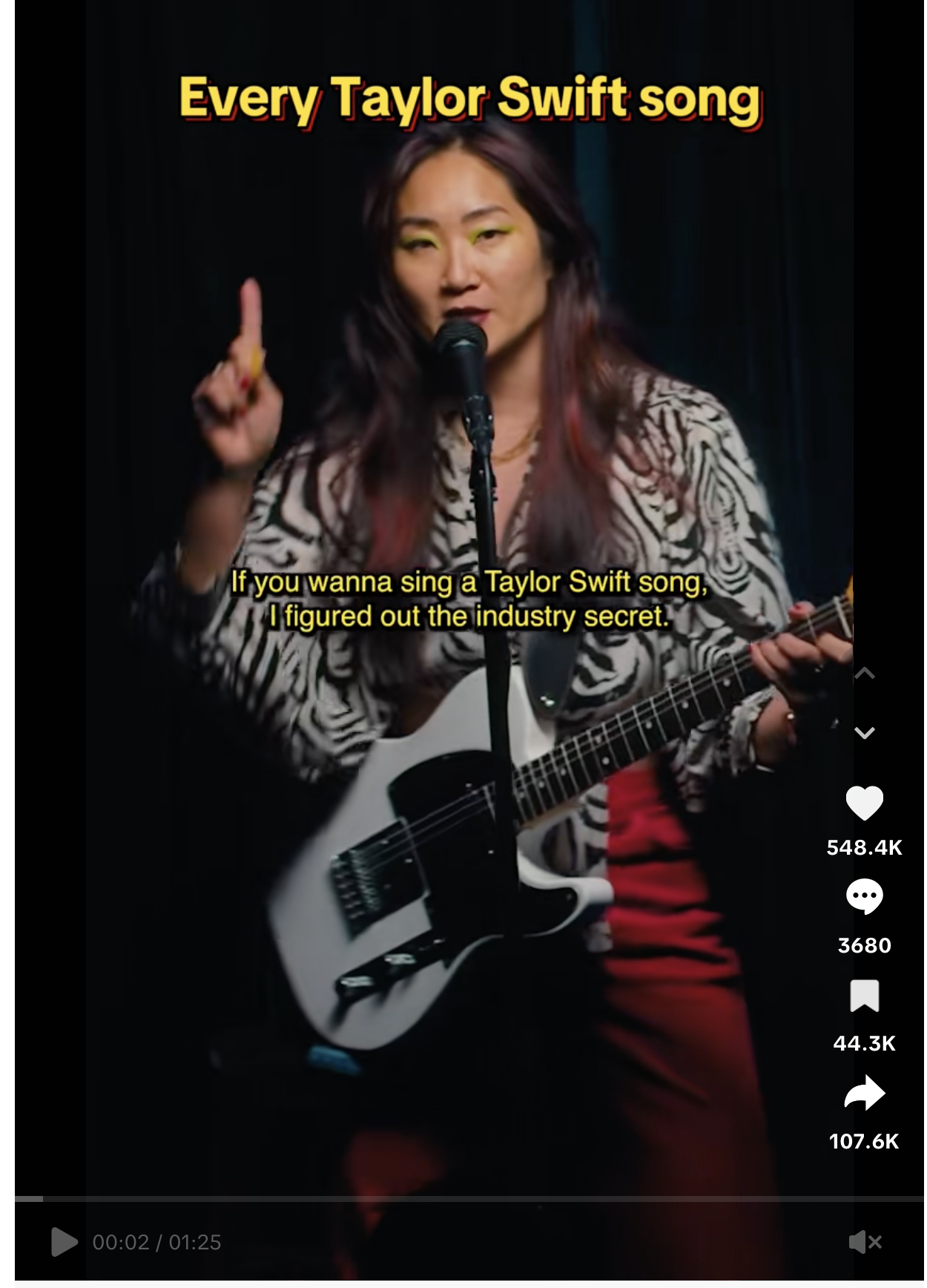
Why West Side Story is a Masterpiece
